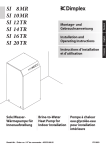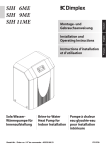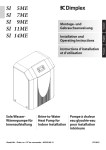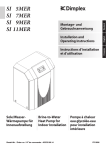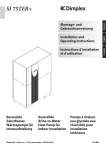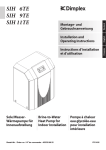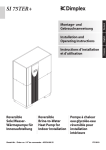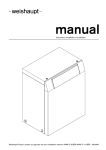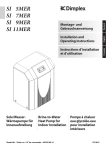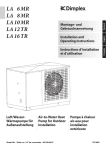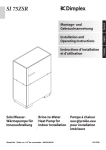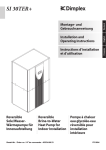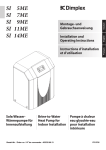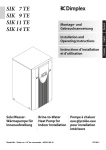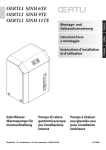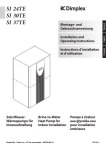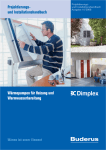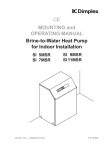Download Dimplex LA 8MR Operating instructions
Transcript
Sole/WasserWärmepumpe für Innenaufstellung Installation and Operating Instructions English Montage- und Gebrauchsanweisung Instructions d’installation et d’utilisation Brine-to-Water Heat Pump for Indoor Installation Bestell-Nr. / Order no. / No de commande : 452233.66.02 Deutsch 8 MR 10 MR 12 TR 14 TR 16 TR 20 TR Français SI SI SI SI SI SI Pompe à chaleur eau glycolée-eau pour installation intérieure FD 8605 Inhaltsverzeichnis Bitte sofort lesen .......................................................................................................................... D-2 1.1 Wichtige Hinweise ..................................................................................................................................D-2 1.2 Gesetzliche Vorschriften und Richtlinien ................................................................................................D-2 1.3 Energiesparende Handhabung der Wärmepumpe .................................................................................D-2 2 Verwendungszweck der Wärmepumpe ...................................................................................... D-2 2.1 Anwendungsbereich ...............................................................................................................................D-2 2.2 Arbeitsweise ...........................................................................................................................................D-2 3 Grundgerät.................................................................................................................................... D-3 4 Zubehör ......................................................................................................................................... D-3 4.1 Soleverteiler............................................................................................................................................D-3 5 Transport....................................................................................................................................... D-3 6 Aufstellung.................................................................................................................................... D-4 6.1 Allgemeine Hinweise ..............................................................................................................................D-4 6.2 Schallemissionen....................................................................................................................................D-4 7 Montage......................................................................................................................................... D-4 7.1 7.2 7.3 7.4 8 Allgemein ................................................................................................................................................D-4 Heizungsseitiger Anschluss....................................................................................................................D-4 Wärmequellenseitiger Anschluss............................................................................................................D-5 Elektrischer Anschluss............................................................................................................................D-5 Inbetriebnahme............................................................................................................................. D-5 8.1 Allgemein ................................................................................................................................................D-5 8.2 Vorbereitung ...........................................................................................................................................D-5 8.3 Vorgehensweise bei Inbetriebnahme .....................................................................................................D-5 9 Funktionsbeschreibung Steuerung ............................................................................................ D-6 9.1 9.2 9.3 9.4 Bedienelemente......................................................................................................................................D-6 Funktion Heizen......................................................................................................................................D-6 Funktion Kühlen......................................................................................................................................D-6 Funktion Warmwasser ............................................................................................................................D-6 10 Pflege / Reinigung ........................................................................................................................ D-7 10.1 Pflege......................................................................................................................................................D-7 10.2 Reinigung Heizungsseite ........................................................................................................................D-7 10.3 Reinigung Wärmequellenseite................................................................................................................D-7 11 Störungen / Fehlersuche ............................................................................................................. D-7 12 Außerbetriebnahme / Entsorgung .............................................................................................. D-7 13 Geräteinformation ........................................................................................................................ D-8 14 Garantieurkunde........................................................................................................................... D-9 Anhang / Appendix / Annexes ............................................................................................................ A-I www.dimplex.de D-1 Deutsch 1 1 1 Bitte sofort lesen 1.1 1.3 Wichtige Hinweise Deutsch ACHTUNG! Die Wärmepumpe ist nicht am Holzrost befestigt. ACHTUNG! Die Wärmepumpe darf nur bis zu einer Neigung von maximal 45° (in jeder Richtung) gekippt werden. ACHTUNG! Gerät nicht an den Bohrungen in den Verkleidungsblechen anheben! ACHTUNG! Durch das Betreiben dieser Wärmepumpe tragen Sie zur Schonung unserer Umwelt bei. Für den effizienten Betrieb ist eine sorgfältige Bemessung der Heizungs- bzw. Kühlungsanlage und der Wärmequelle sehr wichtig. Dabei ist im Heizbetrieb besonderes Augenmerk auf möglichst niedrige Wasservorlauftemperaturen zu richten. Darum sollten alle angeschlossenen Energieverbraucher für niedrige Vorlauftemperaturen geeignet sein. Eine um 1 K höhere Heizwassertemperatur steigert den Energieverbrauch um ca. 2,5 %. Eine Niedertemperaturheizung mit Vorlauftemperaturen zwischen 30 °C und 50 °C ist für einen energiesparenden Betrieb gut geeignet. 2 Vor Anschluss der Wärmepumpe Heizungsanlage spülen. ACHTUNG! Bei großvolumigen Heizkreisen muss das Ausdehnungsgefäß durch ein weiteres ergänzt werden. eingebaute ACHTUNG! Im Wärmequelleneintritt der Wärmepumpe ist ein Schmutzfänger zu montieren, um den Verdampfer gegen Verunreinigungen zu schützen. ACHTUNG! Die Sole muss mindestens zu 25 % aus einem Frostschutz auf Monoethylenglykol- oder Propylenglykolbasis bestehen und ist vor dem Befüllen zu mischen. ACHTUNG! Bei Frostgefahr startet die Umwälzpumpe auch im Standbymodus sofort nach Anlegen der Netzspannung. ACHTUNG! Zur Vermeidung von Ablagerungen (z.B. Rost) im Kondensator der Wärmepumpe wird empfohlen, ein geeignetes Korrosionsschutzsystem einzusetzen. ACHTUNG! Arbeiten an der Wärmepumpe dürfen nur vom autorisierten und sachkundigen Kundendienst durchgeführt werden. ACHTUNG! Vor öffnen des Gerätes sind alle Stromkreise spannungsfrei zu schalten. 1.2 Gesetzliche Vorschriften und Richtlinien Energiesparende Handhabung der Wärmepumpe Verwendungszweck der Wärmepumpe 2.1 Anwendungsbereich Die Sole/Wasser-Wärmepumpe kann in vorhandenen oder neu zu errichtenden Heizungsanlagen eingesetzt werden. Als Wärmeträger in der Wärmequellenanlage dient Sole. Als Wärmequelle können Erdsonden, Erdkollektoren oder ähnliche Anlagen genutzt werden. 2.2 Arbeitsweise Heizen Das Erdreich speichert Wärme die von Sonne, Wind und Regen eingebracht wird. Diese Erdwärme wird im Erdkollektor, der Erdsonde oder ähnlichem von der Sole bei niedriger Temperatur aufgenommen. Eine Umwälzpumpe fördert dann die "erwärmte" Sole in den Verdampfer der Wärmepumpe. Dort wird diese Wärme an das Kältemittel im Kältekreislauf abgegeben. Dabei kühlt sich die Sole wieder ab, so dass sie im Solekreis wieder Wärmeenergie aufnehmen kann. Das Kältemittel wird vom elektrisch angetriebenen Verdichter angesaugt, verdichtet und auf ein höheres Temperaturniveau "gepumpt". Die bei diesem Vorgang zugeführte elektrische Antriebsleistung geht nicht verloren, sondern wird größtenteils dem Kältemittel zugeführt. Daraufhin gelangt das Kältemittel in den Verflüssiger und überträgt hier wiederum seine Wärmeenergie an das Heizwasser. Abhängig vom Betriebspunkt erwärmt sich so das Heizwassser auf bis zu 60 °C. Die Wärmepumpe entspricht allen relevanten DIN-/VDE-Vorschriften und EG-Richtlinien. Diese können der CE-Erklärung im Anhang entnommen werden. Kühlen Der elektrische Anschluss der Wärmepumpe muss nach den gültigen VDE-, EN- und IEC-Normen ausgeführt werden. Zusätzlich sind die Anschlussbedingungen der Versorgungsunternehmen zu beachten. Das Heizwasser gibt über den nun als Verdampfer arbeitenden Verflüssiger die Wärme an das Kältemittel ab. Mit dem Verdichter wird das Kältemittel auf ein höheres Temperaturniveau gebracht. Über den Verflüssiger (im Heizbetrieb Verdampfer) gelangt die Wärme in die Sole und somit ins Erdreich. Die Wärmepumpe ist entsprechend den einschlägigen Vorschriften in die Wärmequellen- und Heizungsanlage bzw. Kühlanlage einzubinden. D-2 In der Betriebsart Kühlen werden Verdampfer und Verflüssiger in ihrer Wirkungsweise umgekehrt. 5 Grundgerät 4 Das Grundgerät besteht aus einer anschlussfertigen Wärmepumpe für Innenaufstellung mit Blechgehäuse, Schaltblech und integrierter Steuerung. Im Kältekreis ist das Kältemittel R407C eingefüllt. Das Kältemittel R407C ist FCKW-frei, baut kein Ozon ab und ist nicht brennbar. Am Schaltblech sind alle für den Betrieb der Wärmepumpe notwendigen Bauteile angebracht. Die Spannungszuführung für Last- und Steuerstrom ist bauseits zu verlegen. Zubehör 4.1 Soleverteiler Der Soleverteiler vereinigt die Kollektorschleifen der Wärmequellenanlage zu einer Hauptleitung, welche an die Wärmepumpe angeschlossen wird. Mittels der integrierten Kugelhähne können zum Entlüften einzelne Solekreise abgesperrt werden. Der Kollektor mit Soleverteiler ist bauseits zu erstellen. 5 Transport Zum Transport auf ebenem Untergrund eignet sich ein Hubwagen. Muss die Wärmepumpe auf unebenem Untergrund oder über Treppen befördert werden, kann dies mit Tragriemen geschehen. Diese können direkt unter dem Holzrost hindurchgeführt werden. ACHTUNG! Die Wärmepumpe ist nicht am Holzrost befestigt. 1) Verflüssiger 2) Schaltblech 3) Verdichter 4) Heizungspumpe 5) Verdampfer 6) Primärpumpe ACHTUNG! Die Wärmepumpe darf nur bis zu einer Neigung von maximal 45° (in jeder Richtung) gekippt werden. Zum Anheben des Gerätes ohne Palette sind die seitlich im Rahmen vorgesehenen Bohrungen zu benutzen. Die seitlichen Verkleidungsbleche sind dabei abzunehmen. Als Tragehilfe kann ein handelsübliches Rohr dienen. ACHTUNG! Gerät nicht an den Bohrungen in den Verkleidungsblechen anheben! www.dimplex.de D-3 Deutsch 3 6 6 6.1 Aufstellung Allgemeine Hinweise Deutsch Das Gerät ist grundsätzlich in Innenräumen auf einer ebenen, glatten und waagrechten Fläche aufzustellen. Dabei sollte der Rahmen rundum dicht am Boden anliegen, um eine geeignete Schallabdichtung zu gewährleisten. Ist dies nicht der Fall, können zusätzliche schalldämmende Maßnahmen notwendig werden. Die Wärmepumpe muss so aufgestellt sein, dass ein Kundendiensteinsatz problemlos durchgeführt werden kann. Dies ist gewährleistet, wenn ein Abstand von ca. 1 m vor und neben der Wärmepumpe eingehalten wird. 7 Montage 7.1 Allgemein An der Wärmepumpe sind folgende Anschlüsse herzustellen: Vor-/Rücklauf Soleanlage Vor-/Rücklauf Heizung Stromversorgung Abläufe der Überdruckventile 7.2 Heizungsseitiger Anschluss ACHTUNG! Vor Anschluss der Wärmepumpe Heizungsanlage spülen. Bevor die heizwasserseitigen Anschlüsse der Wärmepumpe erfolgen, muss die Heizungsanlage gespült werden, um eventuell vorhandene Verunreinigungen, Reste von Dichtmaterial oder ähnliches, zu entfernen. Ein Ansammeln von Rückständen im Verflüssiger kann zum Totalausfall der Wärmepumpe führen. Nach erstellter heizungsseitiger Installation ist die Heizungsanlage zu füllen, zu entlüften und abzudrücken. Die Druckanzeige befindet sich an der Bedienblende. Mindestheizwasserdurchsatz 6.2 Schallemissionen Aufgrund der wirkungsvollen Schallisolation arbeitet die Wärmepumpe sehr leise. Um eine Schwin-gungsübertragung auf das Fundament zu verhindern, sollte eine geeignete, dämpfende Gummimatte unter den Grundrahmen der Wärmepumpe gelegt werden. Um die Übertragung von Geräuschen in das Heizsystem zu vermeiden, empfiehlt es sich, die Wärmepumpe mit Schlauchstücken an das Heizsystem zu koppeln. Der Mindestheizwasserdurchsatz der Wärmepumpe ist in jedem Betriebszustand der Heizungsanlage sicherzustellen. Dieses kann z.B. durch Installation eines differenzdrucklosen Verteilers oder eines Überströmventiles erreicht werden. Die Einstellung eines Überströmventiles ist in Kapitel Inbetriebnahme erklärt. Frostschutz bei frostgefährdeter Aufstellung Sofern die Wärmepumpe betriebsbereit ist, arbeitet die Frostschutzfunktion der Steuerung. Bei Außer-betriebnahme der Wärmepumpe oder Stromausfall ist die Anlage zu entleeren. Bei Wärmepum-penanlagen, an denen ein Stromausfall nicht erkannt werden kann (Ferienhaus), ist der Heizungskreis mit seinem geeigneten Frostschutz zu betreiben. Das integrierte Ausdehnungsgefäß hat ein Volumen von 8 Liter. Eine Überprüfung des Volumens ist durch den Anlagenplaner durchzuführen. Gegebenenfalls ist ein weiteres Ausdehnungsgefäß zu installieren. ACHTUNG! Bei großvolumigen Heizkreisen muss das Ausdehnungsgefäß durch ein weiteres ergänzt werden. D-4 eingebaute 8.3 Wärmequellenseitiger Anschluss Folgende Vorgehensweise ist beim Anschluss einzuhalten: Die Soleleitung am Vor- und Rücklauf der Wärmepumpe anschließen. ACHTUNG! Im Wärmequelleneintritt der Wärmepumpe ist ein Schmutzfänger zu montieren, um den Verdampfer gegen Verunreinigungen zu schützen. Zusätzlich muss ein Entlüfter am höchsten Punkt der Wärmequellenanlage eingebaut werden. Die Sole ist vor dem Befüllen der Anlage herzustellen. Die Solekonzentration muss mindestens 25 % betragen. Das gewährleistet Frostsicherheit bis -14°C. 8 Inbetriebnahme 8.1 Allgemein Um eine ordnungsgemäße Inbetriebnahme zu gewährleisten, sollte diese von einem vom Werk autorisierten Kundendienst durchgeführt werden. Unter bestimmten Bedingungen ist damit eine Verlängerung der Gewährleistung verbunden (vgl. Garantieleistung). Die Inbetriebnahme hat im Heizbetrieb zu erfolgen. 8.2 Vorbereitung Vor der Inbetriebnahme müssen folgende Punkte geprüft werden: Alle Anschlüsse der Wärmepumpe müssen, wie in Kapitel 7 beschrieben, montiert sein. Es dürfen nur Frostschutzmittel auf Monoethylenglykol- oder Propylenglykolbasis verwendet werden. Die Wärmequellenanlage und der Heizkreis müssen gefüllt und geprüft sein. Die Wärmequellenanlage ist zu entlüften und auf Dichtheit zu prüfen. Die Druckanzeige befindet sich an der Bedienblende. Der Schmutzfänger muss im Soleeintritt der Wärmepumpe eingebaut sein. ACHTUNG! Im Sole- und Heizkreislauf müssen alle Schieber, die den korrekten Fluss behindern könnten, geöffnet sein. Die Sole muss mindestens zu 25 % aus einem Frostschutz auf Monoethylenglykol- oder Propylenglykolbasis bestehen und ist vor dem Befüllen zu mischen. 8.3 7.4 Die Inbetriebnahme der Wärmepumpe erfolgt über Schalter (1). Elektrischer Anschluss An der Wärmepumpe muss der Anschluss der Netzzuleitung am Schaltblech über Klemmen X1 hergestellt werden. ACHTUNG! Bei Frostgefahr startet die Umwälzpumpe auch im Standbymodus sofort nach Anlegen der Netzspannung. Alle für den Betrieb der Wärmepumpe notwendigen elektrischen Bauteile befinden sich am Schaltblech. Wärmepumpe - Sondertarif Viele Energieversorgungsunternehmen bieten für Wärmepumpen ein Sonderabkommen mit einem günstigeren Strompreis an. Im Gegenzug ist das EVU in der Lage bei Lastspitzen die Wärmepumpe zu sperren. In diesen Fall sind eine allpolige Abschaltung mit mindestens 3 mm Kontaktöffnungsabstand (z.B. EVU-Sperrschütz oder Leistungsschütz), sowie ein Sicherungsautomat, mit gemeinsamer Auslösung aller Außenleiter vorzusehen. Der benötigte Leiterquerschnitt ist gemäß der Leistungsaufnahme der Wärmepumpe, der technischen Anschlussbe-dingungen des jeweiligen EVU und nach den einschlägigen Vorschriften zu wählen. Die Leistungsaufnahme der Wärmepumpe entnehmen Sie der Produktinformation oder dem Typschild. Die Anschlussklemmen sind für max. 10 mm2 Leiterquerschnitt ausgelegt. www.dimplex.de Vorgehensweise bei Inbetriebnahme Wird der Mindestheizwasserdurchsatz mittels Überströmventil sichergestellt, so ist dieses auf die Heizungsanlage abzustimmen. Eine falsche Einstellung kann zu verschiedenen Fehlerbildern und einem erhöhten elektrischen Energiebedarf führen. Um das Überströmventil richtig einzustellen, empfehlen wir folgende Vorgehensweise: Schließen Sie alle Heizkreise, die auch im Betrieb je nach Nutzung geschlossen sein können, so dass der vom Wasserdurchsatz ungünstigste Betriebszustand vorliegt. Dies sind in der Regel die Heizkreise der Räume auf der Süd- und Westseite. Mindestens ein Heizkreis muss geöffnet bleiben (z.B. Bad). Das Überströmventil ist so weit zu öffnen, dass sich bei der aktuellen Wärmequellentemperatur die in der unten stehenden Tabelle angegebene maximale Temperaturspreizung zwischen Heizungsvor- und Rücklauf ergibt. Die Temperaturspreizung ist mög-lichst nahe an der Wärmepumpe zu messen. Bei monoenergetischen Anlagen ist der Heizstab zu deaktivieren. Wärmequellentemperatur von bis max. Temperaturspreizung zwischen Heizungsvor- und Rücklauf -5° C 0° C 10 K 1° C 5° C 11 K 6° C 9° C 12 K 13 K 10° C 14° C 15° C 20° C 14 K 21° C 25° C 15 K D-5 Deutsch 7.3 9 9 Funktionsbeschreibung Steuerung 9.1 9.2 Bedienelemente Deutsch 1) Schalter Ein/Standby 2) Schalter Heizen/Kühlen 3) Anzeige (leuchtet, wenn WP an Spannung liegt) 4) Sollwertpotenziometer (Rücklauf) 5) Druckanzeige Solekreis 6) Druckanzeige Heizungskreis 7) Temperaturanzeige Heizungskreis Schalter (1) schaltet die Wärmepumpe in Bereitschaft (I) bzw. in den Standby-Modus ( ). Die Heizungsumwälzpumpe ist als Dauerläufer in Schalterstellung I eingeschaltet. Die Umschaltverzögerung von Heizbetrieb in Kühlbetrieb bzw. umgekehrt beträgt ca. 10 Minuten. Funktion Heizen Mit Schalter (1) auf Stellung Ein (I) wird die Wärmepumpe in Betriebe genommen. Mit Schalter (2) auf Stellung Heizen ( ) wird der Heizbetrieb vorgewählt. Die gewünschte Rücklauftemperatur wird über Drehknopf (4) eingestellt. Die Anforderung über Potentiometer liegt im Bereich zwischen min. 20 °C und max. 55 °C. Die tatsächliche Temperatur kann an der Anzeige (3) an der Bedienblende abgelesen werden. Wird die eingestellte Temperatur erreicht, schaltet die Wärmepumpe aus, sinkt die Rücklauftemperatur um 4 Kelvin unter den eingestellten Wert, schaltet die Wärmepumpe wieder ein. Bei Nichterreichen der eingestellten Rücklauftemperatur wird nach ca. 1 Stunde der Ausgang für den 2. Wärmeerzeuger zugeschaltet. Eine Wiedereinschaltung der Wärmepumpe ist erst nach einer Mindeststandzeit von 5 Minuten möglich. Bei einer Vorlauftemperatur von über 60 °C, bzw. bei zu niedriger Soletemperatur schaltet die Wärmepumpe aus. 9.3 Funktion Kühlen Mit Schalter (1) auf Stellung Ein (I) wird die Wärmepumpe in Betrieb genommen. Mit Schalter (2) auf Stellung Kühlen ( ) wird der Kühlbetrieb vorgewählt. Die gewünschte Rücklauftemperatur wird durch Drehknopf (4) eingestellt. Die Anforderung über Potentiometer liegt im Bereich zwischen min. 12 °C und max. 25 °C. Wird die eingestellte Temperatur erreicht, schaltet die Wärmepumpe aus, steigt die Rücklauftemperatur um 4 Kelvin über den eingestellten Wert, schaltet die Wärmepumpe wieder ein. Eine Wiedereinschaltung der Wärmepumpe ist erst nach einer Mindeststandzeit von 5 Minuten möglich. Bei einer Vorlauftemperatur von unter 7 °C schaltet die Wärmepumpe aus. Um eine Betauung der Anlage bei Flächenkühlung zu verhindern, wird empfohlen, Taupunktwächter an den sensiblen Stellen des Kälteverteilsystems einzubauen und an der Klemme X1 (1,2) anzuschließen. Beim Auftreten von Betauung wird dann der Kühlbetrieb der Anlage unterbrochen. 9.4 Funktion Warmwasser Mit dieser Wärmepumpe kann auch Warmwasser erwärmt werden. 1) ein = Verdichter läuft 2) ein = Soleumwälzpumpe läuft 3) ein = Umschaltventil auf "Kühlen“ aus = Umschaltventil auf "Heizen" 4) ein = Heizungsumwälzpumpe läuft 5) ein = Ausgang 2. Wärmeerzeuger aus 6) ein = Frostschutzanforderung WP heizt aus = Frostschutzanforderung aus 7) ein = Niederdruckpressostat in Ordnung 8) nicht benutzt 9) nicht benutzt 10) nicht benutzt 11) blinkt bei Betrieb 12) blinkt bei Störung Die Anforderung zur Warmwasserbereitung erfolgt über die Klemme "X1-9" durch einen extern beizustellenden Thermostaten. Dieser Thermostat schaltet die Phase (L) auf die Klemme "X1-9" und gleichzeitig die Warmwasser-Umwälzpumpe ein. Ein dafür passender Thermostat steht als Zubehör zur Verfügung. Die Anforderung zur Warmwasserbereitung kann auch ohne anstehende Heiz- oder Kühlanforderung erfolgen. Steht eine Anforderung an, wird von der Steuerung die Heizungs-Umwälzpumpe abgeschaltet, der Kühlbetrieb unterbrochen und der Sollwert auf Maximum gestellt. Die Warmwassersolltemperatur wird durch den externen Thermostaten vorgegeben. Die eingestellte Temperatur sollte ca. 10K unter der max. Vorlauftemperatur der Wärmepumpe eingestellt werden, um ein Abschalten über den Hoch-druckpressostaten zu verhindern. Nach Beendigung der Warmwasserbereitung wird in der gleichen Funktion weitergearbeitet wie vor der Anforderung. D-6 10 Pflege / Reinigung 11 Störungen / Fehlersuche 10.1 Pflege Diese Wärmepumpe ist ein Qualitätsprodukt und sollte störungsfrei arbeiten. Tritt dennoch einmal eine Störung auf, können Sie diese in den meisten Fällen leicht selbst beheben. Die Wärmepumpe arbeitet wartungsfrei. Um Betriebsstörungen durch Schmutzablagerungen in den Wärmeaustauschern zu vermeiden, ist dafür Sorge zu tragen, dass keinerlei Verschmutzungen in die Wärmequellen- und Heizungsanlage gelangen können. Sollte es dennoch zu derartigen Betriebsstörungen kommen, ist die Anlage wie unten angegeben zu reinigen. 10.2 Reinigung Heizungsseite Sauerstoff kann im Heizwasserkreis, insbesondere bei Verwendung von Stahlkomponenten, Oxidationsprodukte (Rost) bilden. Diese gelangen über Ventile, Umwälzpumpen oder Kunststoffrohre in das Heizsystem. Deshalb sollte besonders bei den Rohren der Fußbodenheizung auf eine diffusionsdichte Installation geachtet werden. ACHTUNG! Zur Vermeidung von Ablagerungen (z.B. Rost) im Kondensator der Wärmepumpe wird empfohlen, ein geeignetes Korrosionsschutzsystem einzusetzen. Auch Reste von Schmier- und Dichtmitteln können das Heizwasser verschmutzen. Wenn die Störung nicht selbst behoben werden kann, verständigen Sie bitte den zuständigen Kundendienst. ACHTUNG! Arbeiten an der Wärmepumpe dürfen nur vom autorisierten und sachkundigen Kundendienst durchgeführt werden. ACHTUNG! Vor öffnen des Gerätes sind alle Stromkreise spannungsfrei zu schalten. 12 Außerbetriebnahme / Entsorgung Bevor die Wärmepumpe ausgebaut wird, ist die Maschine spannungsfrei zu schalten und abzu-schiebern. Umweltrelevante Anforderungen, in Bezug auf Rückgewinnung, Wiederverwendung und Entsorgung von Betriebsstoffen und Bauteilen gemäß den gängigen Normen, sind einzuhalten. Dabei ist besonders Wert auf eine fachgerechte Entsorgung des Kältemittels und Kälteöles zu legen. Sind die Verschmutzungen so stark, dass sich die Leistungsfähigkeit des Verflüssigers in der Wärmepumpe verringert, muss ein Installateur die Anlage reinigen. Nach heutigem Kenntnisstand schlagen wir vor, die Reinigung mit einer 5%-igen Phosphorsäure oder, falls häufiger gereinigt werden muss, mit einer 5%-igen Ameisensäure durchzuführen. In beiden Fällen sollte die Reinigungsflüssigkeit Raumtemperatur haben. Es ist empfehlenswert, den Wärmeaustauscher entgegen der normalen Durchflußrichtung zu spülen. Um zu verhindern, dass säurehaltiges Reinigungsmittel in den Heizungsanlagenkreislauf gelangt, empfehlen wir, das Spülgerät direkt an den Vor- und Rücklauf des Verflüssigers der Wärmepumpe anzuschließen. Danach muss mit geeigneten neutralisierenden Mitteln gründlich nachgespült werden, um Beschädigungen durch eventuell im System verbliebene Reinigungsmittelreste zu verhindern. Die Säuren sind mit Vorsicht anzuwenden und es sind die Vorschriften der Berufsgenossenschaften einzuhalten. Im Zweifelsfall ist mit dem Hersteller des Reinigungsmittels Rücksprache zu halten! 10.3 Reinigung Wärmequellenseite ACHTUNG! Im Wärmequelleneintritt der Wärmepumpe ist ein Schmutzfänger zu montieren, um den Verdampfer gegen Verunreinigungen zu schützen. Einen Tag nach der Inbetriebnahme sollte das Filtersieb des Schmutzfängers gereinigt werden, danach wöchentlich reinigen. Sind keine Verunreinigungen mehr erkennbar, kann das Sieb des Schmutzfängers ausgebaut werden, um die Druckverluste zu reduzieren. www.dimplex.de D-7 Deutsch 12 13 13 Geräteinformation Geräteinformation für Sole/Wasser-Heiz-Wärmepumpen Deutsch 1 Typ- und Verkaufsbezeichnung 2 Bauform SI 8MR SI 10MR SI 12TR SI 14TR SI 16TR SI 20TR 2.1 Ausführung 2.2 Schutzart nach EN 60 529 Reversibel Reversibel Reversibel Reversibel Reversibel Reversibel IP 20 IP 20 IP 20 IP 20 IP20 IP20 2.3 Aufstellungsort Innen Innen Innen Innen Innen Innen 3 Leistungsangaben 3.1 Temperatur-Betriebseinsatzgrenzen: bis 60 bis 60 bis 60 bis 60 bis 60 bis 60 Heizwasser-Vorlauf °C Kühlen, Vorlauf °C Sole (Wärmequelle, Heizen) °C -5 bis +25 -5 bis +25 -5 bis +25 -5 bis +25 -5 bis +25 -5 bis +25 Sole (Wärmesenke, Kühlen) °C +5 bis +25 +5 bis +25 +5 bis +25 +5 bis +25 +5 bis +25 +5 bis +25 +7 bis +20 +7 bis +20 +7 bis +20 +7 bis +20 +7 bis +20 +7 bis +20 Monoethy- Monoethy- Monoethy- Monoethy- Monoethy- Monoethylenglykol lenglykol lenglykol lenglykol lenglykol lenglykol Frostschutzmittel Minimale Solekonzentration (-13°C Einfriertemperatur) 25% 25% 25% 25% 25% 25% 3.2 Heizwasser-Temperaturspreizun bei B0 / W35 K 10.6 9.9 9.9 9.4 9.6 10.7 3.3 Wärmeleistung / Leistungszahl bei B-5 / W55 1 kW / --- 7,5 / 2,0 9,8 / 2,1 9,8 / 2,1 12,2 / 2,3 14,1 / 2,4 18,7 /2,5 bei B0 / W50 1 kW / --- 8,8 / 2,8 11,3 / 2,9 11,3 / 2,9 13,5 / 2,9 16,3 / 3,2 20,4 / 3,1 20,0 / 4,2 kW / --- 9,3 / 4,0 11,6 / 4,1 11,6 / 4,1 13,7 / 4,0 16,4 / 4,0 bei B20 / W8 kW / --- 9,9 / 4,6 11,4 / 4,6 11,4 / 4,6 14,1 / 5,0 17,3 / 4,9 21,5 / 4,9 bei B20 / W18 kW / --- 12,0 / 54 14,1 / 5,3 14,1 / 5,3 17,4 / 5,9 21,5 / 5,9 26,0 / 5,7 bei B10 / W8 kW / --- 9,9 / 5,6 11,6 / 5,7 11,6 / 5,7 14,7 / 6,4 18,0 / 6,4 21,9 / 5,9 kW / --- 12,4 / 6,7 14,1 / 6,5 14,1 / 6,5 17,4 / 7,1 21,5 / 7,3 27,7 / 7,1 54 55 56 56 56 56 bei B0 / W35 3.4 Kühlleistung, Leistungszahl 1 bei B10 / W18 3.5 Schall-Leistungspegel dB(A) 3.6 Heizwasserdurchfluß bei interner Druckdifferenz m³/h / Pa 0,75/ 2300 1,0 / 4100 1,0 / 4100 1,3 / 4850 1,5 / 4000 1,6 / 3400 3.7 Soledurchsatz bei interner Druckdifferenz (Wärmequelle) m³/h / Pa 2,3 / 25000 3,0 / 24000 3,0 / 24000 3,5 / 17900 3,8 / 18400 3,5 / 13900 3.8 Kältemittel; Gesamt-Füllgewicht 4 Abmessungen, Anschlüsse und Gewicht 4.1 Geräteabmessungen ohne Anschlüsse 2 H x B x L mm 4.2 Geräteanschlüsse für Heizung Zoll G 1" a G 1" a G 1" a G 1" a G 1" a G 1" a 4.3 Geräteanschlüsse für Wärmequelle Zoll G 1" a G 1" a G 1" a G 1" a G 1¼" a G 1¼" a 4.4 Gewicht der Transporteinheit(en) incl. Verpackung kg 162 163 164 166 172 237 230 / 20 230 / 25 400 / 16 400 / 16 400 / 16 400 / 16 2.3 2.8 2.8 3.41 4.1 4.8 5 Elektrischer Anschluss 5.1 Nennspannung; Absicherung 5.2 Nennaufnahme 1 B0 W35 kW Anlaufstrom m. Sanftanlasser A 5.4 Nennstrom B0 W35 / cosϕ A / --- 6 Entspricht den europäischen Sicherheitsbestimmungen 7 Sonstige Ausführungsmerkmale 7.1 Wasser im Gerät gegen Einfrieren geschützt 4 7.2 Leistungsstufen R407C / 1,5 R407C / 1,4 R407C / 2,1 R407C / 2,4 R407C / 3,2 1220 x 640 1220 x 640 1220 x 640 1220 x 640 1220 x 640 1220 x 640 x 624 x 624 x 624 x 624 x 624 x 624 V/A 5.3 7.3 R407C / 1,3 Typ / kg Regler intern / extern 38 38 26 26 30 30 12,5 / 0,8 15,2 / 0,8 4,8 / 0,8 6,2 / 0,8 7,4 / 0,8 11,0 / 0,8 3 3 3 3 3 3 nein nein nein nein nein nein 1 1 1 1 1 1 intern intern intern intern intern intern 1. Diese Angaben charakterisieren die Größe und die Leistungsfähigkeit der Anlage. Für wirtschaftliche und energetische Betrachtungen sind Bivalenzpunkt und Regelung zu berücksichtigen. Dabei bedeuten z.B. B10 / W55: Wärmequellentemperatur 10 °C und Heizwasser-Vorlauftemperatur 55 °C. 2. Beachten Sie, dass der Platzbedarf für Rohranschluss, Bedienung und Wartung größer ist. 3. s. CE-Konformitätserklärung 4. Die Heizungsumwälzpumpe und der Regler der Wärmepumpe müssen immer betriebsbereit sein. D-8 14 Garantieurkunde Die nachstehenden Bedingungen, die Voraussetzungen und Umfang unserer Garantieleistung umschreiben, lassen die Gewährleistungsverpflichtungen des Verkäufers aus dem Kaufvertrag mit dem Endabnehmer unberührt. Für die Geräte leisten wir Garantie gemäß nachstehenden Bedingungen: Wir beheben unentgeltlich nach Maßgabe der folgenden Bedingungen Mängel am Gerät, die nachweislich auf einem Materialund/oder Herstellungsfehler beruhen, wenn sie uns unverzüglich nach Feststellung und innerhalb von 24 Monaten nach Lieferung an den Erstendabnehmer gemeldet werden. Bei gewerblichem Gebrauch innerhalb von 12 Monaten. Zeigt sich der Mangel innerhalb von 6 Monaten ab Lieferung und liegt eine erfolgreiche Inbetriebnahme (Heizungs-Wärmepumpe und zentrale Wohnungslüftungsgeräte) durch den autorisierten SystemtechnikKundendienst vor, wird vermutet, dass es sich um einen Material- oder Herstellungsfehler handelt. Dieses Gerät fällt nur dann unter diese Garantie, wenn es von einem Unternehmer in einem der Mitgliedstaaten der Europäischen Union gekauft wurde, es bei Auftreten des Mangels in Deutschland betrieben wird und Garantieleistungen auch in Deutschland erbracht werden können. Die Behebung der von uns als garantiepflichtig anerkannter Mängel geschieht dadurch, dass die mangelhaften Teile unentgeltlich nach unserer Wahl instandgesetzt oder durch einwandfreie Teile ersetzt werden. Durch Art oder Ort des Einsatzes des Gerätes oder schlechte Zugänglichkeit des Gerätes bedingte außergewöhnliche Kosten der Mängelbeseitigung werden nicht übernommen. Der freie Gerätezugang muss durch den Endabnehmer gestellt werden. Ausgebaute Teile, die wir zurücknehmen, gehen in unser Eigentum über. Die Garantiezeit für Nachbesserungen und Ersatzteile endet mit dem Ablauf der ursprünglichen Garantiezeit für das Gerät. Die Garantie erstreckt sich nicht auf leicht zerbrechliche Teile, die den Wert oder die Gebrauchstauglichkeit des Gerätes nur unwesentlich beeinträchtigen. Es ist jeweils der Original-Kaufbeleg mit Kauf- und/ oder Lieferdatum vorzulegen. Eine Garantieleistung entfällt, wenn vom Endabnehmer oder einem Dritten die entsprechenden VDE-Vorschriften, die Bestimmungen der örtlichen Versorgungsunternehmen oder unsere Montage- und Gebrauchsanweisung sowie die in den Projektierungsunterlagen enthaltenen Hinweise oder Einbindungsschemen nicht beachtet worden sind oder wenn unser funktionsnotwendiges Zubehör nicht eingesetzt wurde. Durch etwa seitens des Endabnehmers oder Dritter unsachgemäß vorgenommenen Änderungen und Arbeiten, wird die Haftung für die daraus entstehenden Folgen aufgehoben. Die Garantie erstreckt sich auf das Gerät und vom Lieferer bezogene Teile. Nicht vom Lieferer bezogene Teile und Geräte-/Anlagenmängel die auf nicht vom Lieferer bezogene Teile zurückzuführen sind fallen nicht unter den Garantieanspruch. Eine Verlängerung der Garantie auf 36 Monate für HeizungsWärmepumpen und zentrale Wohnungslüftungsgeräte ab Inbetriebnahmedatum, jedoch maximal 38 Monate ab Auslieferung Werk, wird gemäß den nachfolgenden Bedingungen gewährt: Voraussetzung für die Übernahme der verlängerten Garantie ist eine kostenpflichtige Inbetriebnahme durch den autorisierten Systemtechnik-Kundendienst mit Inbetriebnahmeprotokoll innerhalb einer Betriebszeit (Verdichterlaufzeit) von weniger als 150 Stunden. Im Inbetriebnahmeprotokoll vermerkte Mängel sind unverzüglich zu beseitigen. Dies ist Grundlage für die Garantie. Das Inbetriebnahmeprotokoll ist, innerhalb von einem Monat nach erfolgter Inbetriebnahme, an die unten angegebene Adresse einzureichen, von welcher auch die Garantiezeitverlängerung bestätigt wird. Die Inbetriebnahmepauschale beinhaltet die eigentliche Inbetriebnahme und die Fahrtkosten. Es wird keine Haftung für die ordnungsgemäße Planung, Dimensionierung und Ausführung der Gesamtanlage übernommen. Die Behebung von Anlagenmängel und Wartezeiten sind Sonderleistungen. Die Inbetriebnahmepauschale für alle Heizungs-Wärmepumpen von derzeit netto Euro 340,-- und für zentrale Lüftungsanlagen von netto Euro 400,--, jeweils je Gerät, wird durch den autorisierten Systemtechnik-Kundendienst dem Auftraggeber in Rechnung gestellt. Eine Preisanpassung ist vorbehalten. Im Kundendienstfalle wird der autorisierte Systemtechnik-Kundendienst vor Ort informiert, der für eine schnelle Abhilfe des Problems sorgt. Den für Ihre Region zuständigen autorisierten Systemtechnik-Kundendienst erfahren Sie über die zentrale Servicehotline der Glen Dimplex Deutschland GmbH. Glen Dimplex Deutschland GmbH Geschäftsbereich Dimplex Kundendienst Systemtechnik Am Goldenen Feld 18 95326 Kulmbach Tel.-Nr.: Fax.-Nr.: E-Mail-Adresse: Internet: +49 (0) 9221 709 562 +49 (0) 9221 709 565 [email protected] [email protected] www.dimplex.de Für die Auftragsbearbeitung werden die Erzeugnisnummer E-Nr. und das Fertigungsdatum FD des Gerätes benötigt. Diese Angaben befinden sich auf dem Typschild in dem stark umrandeten Feld. Kundendienstadresse: Sofern der Mangel nicht beseitigt werden kann, oder die Nachbesserung von uns abgelehnt oder unzumutbar verzögert wird, wird der Hersteller entweder kostenfreien Ersatz liefern oder den Minderwert vergüten. Im Falle einer Ersatzlieferung, behalten wir uns die Geltendmachung einer angemessenen Nutzungsanrechnung, für die bisherige Nutzungszeit, vor. Weitergehende oder andere Ansprüche, insbesondere solche auf Ersatz außerhalb des Gerätes entstandener Schäden sind soweit eine Haftung nicht zwingend gesetzlich angeordnet ist ausgeschlossen. Bei einer Haftung nach § 478 BGB wird die Haftung des Lieferers auf die Servicepauschalen des Lieferers als Höchstbetrag beschränkt. www.dimplex.de D-9 Deutsch 14 14 Deutsch D-10 Table of contents 1 Please read immediately...............................................................................................................E-2 1.1 Important information.............................................................................................................................. E-2 1.2 Legal Regulations and Directives ........................................................................................................... E-2 1.3 Energy-Efficient Use of the Heat Pump .................................................................................................. E-2 2 Purpose of the Heat Pump ...........................................................................................................E-2 3 Basic Device ..................................................................................................................................E-3 4 Accessories ...................................................................................................................................E-3 4.1 Brine circuit manifold .............................................................................................................................. E-3 5 Transport........................................................................................................................................E-3 6 Installation .....................................................................................................................................E-4 6.1 General Information ................................................................................................................................ E-4 6.2 Acoustic Emissions................................................................................................................................. E-4 7 Installation .....................................................................................................................................E-4 7.1 7.2 7.3 7.4 8 General Information ................................................................................................................................ E-4 Heating System Connection ................................................................................................................... E-4 Heat Source Connection......................................................................................................................... E-5 Electrical Connection .............................................................................................................................. E-5 Start-up...........................................................................................................................................E-5 8.1 General Information ................................................................................................................................ E-5 8.2 Preparation ............................................................................................................................................. E-5 8.3 Start-Up Procedure................................................................................................................................. E-5 9 Description of the Control System Functions ............................................................................E-6 9.1 9.2 9.3 9.4 Operator Controls ................................................................................................................................... E-6 Heating Function..................................................................................................................................... E-6 Cooling Function..................................................................................................................................... E-6 Hot Water Function................................................................................................................................. E-6 10 Maintenance and Cleaning ...........................................................................................................E-7 10.1 Maintenance ........................................................................................................................................... E-7 10.2 Cleaning of Heating Side ........................................................................................................................ E-7 10.3 Cleaning the Heat Source System.......................................................................................................... E-7 11 Faults and Trouble-shooting........................................................................................................E-7 12 Decommissioning/Disposal .........................................................................................................E-7 13 Device Information ........................................................................................................................E-8 Anhang / Appendix / Annexes ............................................................................................................ A-I www.dimplex.de E-1 English 2.1 Application .............................................................................................................................................. E-2 2.2 Operating Principle ................................................................................................................................. E-2 1 1 Please read immediately 1.1 Important information ATTENTION! The heat pump is not secured to the wooden pallet. ATTENTION! The heat pump must not be tilted more than 45° (in any direction). English ATTENTION! 1.3 Energy-Efficient Use of the Heat Pump By operating this heat pump you are helping to protect our environment. The heating or cooling system and the heat source must be properly designed and dimensioned to ensure efficient operation. It is particularly important to keep water flow temperatures as low as possible in heating operation. All connected energy consumers should therefore be suitable for low flow temperatures. Raising the heating water temperature by 1 K corresponds to an increase in energy consumption of approx. 2.5 %. Low-temperature heating systems with flow temperatures between 30 °C and 50 °C are optimally suited for energy-efficient operation. Do not use the holes in the panel assemblies for lifting the device! ATTENTION! Flush the heating system prior to connecting the heat pump. 2 ATTENTION! In the case of large-volume heating circuits, use an additional expansion vessel to supplement the installed expansion vessel. ATTENTION! Insert a dirt trap in the heat source inlet of the heat pump to protect the evaporator against the ingress of impurities. ATTENTION! The brine solution must contain at least 25 % of an antifreeze agent on a mono-ethylene glycol or propylene glycol basis and must be mixed prior to filling. ATTENTION! When there is danger of frost, the circulating pump will also start immediately in standby mode after connecting the power supply. ATTENTION! To prevent the accumulation of deposits (e.g. rust) we recommend using a suitable corrosion protection system. ATTENTION! Any work on the heat pump may only be performed by authorised and qualified after-sales service technicians. ATTENTION! Disconnect all electrical circuits from the power source prior to opening the device. 1.2 Legal Regulations and Directives This heat pump conforms to all relevant DIN/VDE regulations and EU directives. Refer to the EC Declaration of Conformity in the appendix for details. The heat pump must be connected to the power supply in compliance with all relevant VDE, EN and IEC standards. Any further connection requirements stipulated by local utility companies must also be observed. The heat pump is to be connected to the heat source system and the heating or cooling system in accordance with all applicable regulations. E-2 2.1 Purpose of the Heat Pump Application The brine-to-water heat pump is designed for use in existing or newly built heating systems. Brine is used as the heat transfer medium in the heat source system. Borehole heat exchangers, ground heat collectors or similar systems can be used as the heat source. 2.2 Operating Principle Heating The heat generated by the sun, wind and rain is stored in the ground. This heat stored in the ground is collected at a low temperature by the brine circulating in the ground heat collector, the borehole heat exchanger or a similar system. A circulating pump then conveys the “heated” brine to the evaporator of the heat pump. There the heat is given off to the refrigerant in the refrigerating cycle. This cools the brine so that it can once again absorb thermal energy in the brine circuit. The refrigerant is drawn in by the electrically driven compressor, compressed and “pumped” to a higher temperature level. The electrical power needed to run the compressor is not lost in this process. Most of it is absorbed by the refrigerant. Subsequently, the refrigerant is passed through the condenser where it transfers its heat energy to the heating water. Depending on the set operating point (thermostat setting), the heating water is thus heated up to a max. of 60 °C. Cooling The functions of the evaporator and the liquifier are reversed in the “Cooling” operating mode. The heating water gives up its heat to the refrigerant via the liquifier which is now functioning as an evaporator. The refrigerant is pumped to a higher temperature level using the compressor. Heat passes into the brine via the liquifier (evaporator in heating operation) and consequently into the ground. 5 3 Basic Device 4 The basic device consists of a ready-to-use heat pump for indoor installation, complete with sheet metal casing, control panel and integrated control system. The refrigerating cycle contains the refrigerant R407C. R407C refrigerant is CFC-free, non-ozone depleting and non-combustible. All components required for the operation of the heat pump are located on the control panel. The power feed for the load current and the control current must be installed by the customer. Accessories 4.1 Brine circuit manifold The brine circuit manifold merges the individual collector loops of the heat source system into a single main pipe which is connected to the heat pump. Integrated ball valves allow the individual brine circuits to be shut off for de-aeration purposes. English The collector including the brine manifold must be provided by the customer. 5 Transport A lift truck is suited for transporting the unit on a level surface. Carrying straps may be used if the heat pump needs to be transported on an uneven surface or carried up or down stairs. These straps can be passed directly underneath the wooden pallet. ATTENTION! The heat pump is not secured to the wooden pallet. 1) Liquifier 2) Control panel 3) Compressor 4) Heating pump ATTENTION! 5) Evaporator The heat pump must not be tilted more than 45° (in any direction). 6) Primary pump Use the holes provided in the sides of the frame to lift the unit without the pallet. The side panel assemblies must be removed for this purpose. Any commercially available length of pipe can be used as a carrying aid. ATTENTION! Do not use the holes in the panel assemblies for lifting the device! www.dimplex.de E-3 6 6 6.1 Installation General Information The unit must be installed indoors on a level, smooth and horizontal surface. The entire base of the frame should lie directly on the floor to ensure a good soundproof seal. If this is not the case, additional sound insulation measures may be necessary. English The heat pump must be installed so that maintenance work can be carried out without being hindered. This can be ensured by maintaining a clearance of approx. 1 m in front of and on each side of the heat pump. 7 Installation 7.1 General Information The following connections need to be established on the heat pump: Flow and return flow of the brine system Flow and return flow of the heating system Power supply Outflows for the pressure relief valves 7.2 Heating System Connection ATTENTION! Flush the heating system prior to connecting the heat pump. Before connecting the heating water system to the heat pump, the heating system must be flushed to remove any impurities, residue from sealants, etc. Any accumulation of deposits in the liquifier could cause the heat pump to completely break down. Once the heating system has been installed, it must be filled, deaerated and pressure-tested. The pressure indicator is located on the control panel. Minimum heating water flow rate 6.2 Acoustic Emissions The heat pump operates silently due to efficient sound insulation. To prevent vibrations from being transmitted to the foundation, a suitable, sound dampening rubber mat should be placed underneath the base frame of the heat pump. To prevent any sound from being transmitted to the heating system, we recommend connecting the heat pump to the heating system by means of hose sections. The minimum heating water flow rate through the heat pump must be assured in all operating states of the heating system. This can be accomplished, for example, by installing either a manifold without differential pressure or an overflow valve. The procedure for adjusting an overflow valve is described in the Chapter Start-Up. Antifreeze protection for installation locations prone to frost The antifreeze function of the heat pump controller is active whenever the heat pump is ready for operation. If the heat pump is taken out of service or in the event of a power failure, the system has to be drained. The heating circuit should be operated with a suitable antifreeze if heat pump systems are implemented in buildings where a power failure can not be detected (holiday home). The integrated expansion vessel has a volume of 8 litres. The volume should be checked by the heating system engineer. Install an additional expansion vessel if necessary. ATTENTION! In the case of large-volume heating circuits, use an additional expansion vessel to supplement the installed expansion vessel. E-4 8.3 Heat Source Connection The following procedure must be observed when connecting the heat source: Connect the brine pipe to the heat pump flow and return. ATTENTION! Insert a dirt trap in the heat source inlet of the heat pump to protect the evaporator against the ingress of impurities. In addition, a breather must be installed at the highest point in the heat source system. The brine liquid must be produced prior to charging the system. The liquid must have an antifreeze concentration of at least 25 % to ensure frost protection down to -14 °C. Only monoethylene glycol or propylene glycol-based antifreeze may be used. The heat source system must be de-aerated and checked for leaks. The pressure indicator is located on the control panel. ATTENTION! The brine solution must contain at least 25 % of an antifreeze agent on a mono-ethylene glycol or propylene glycol basis and must be mixed prior to filling. 7.4 Electrical Connection Connect the mains supply cable to the control panel of the heat pump via terminal X1. ATTENTION! When there is danger of frost, the circulating pump will also start immediately in standby mode after connecting the power supply. All electrical components required for the operation of the heat pump are located on the control panel. Heat pump - special tariff Many utility companies offer a special agreement with a lower electricity tariff when heat pumps are implemented. In return, the utility company is able to block the heat pump at times of peak demand. If this is the case, the customer must provide an all-pole disconnecting device with a contact gap of at least 3 mm (e.g. utility blocking contactor or power contactor) as well as a circuit breaker with common tripping for all external conductors. The required cross-sectional area of the conductor is to be selected according to the power consumption of the heat pump, the technical connection requirements of the relevant utility company as well as all applicable regulations. Details on the power consumption of the heat pump are listed on both the product information sheet and the type plate. The connection terminals are designed for a max. conductor cross-section of 10mm2. www.dimplex.de 8 Start-up 8.1 General Information To ensure that start-up is performed correctly, it should only be carried out by an after-sales service technician authorized by the manufacturer. This will lead, under certain circumstances, to an extension of the warranty period (cf. Warranty). Start-up should be carried out in heating operation. 8.2 Preparation The following items need to be checked prior to start-up: All of the heat pump connections must be established as described in Chapter 7. The heat source system and the heating circuit must have been filled and checked. The dirt trap must have been inserted in the brine inlet of the heat pump. All valves that could impair proper flow in the brine and heating circuits must be open. 8.3 Start-Up Procedure The heat pump is started up using the switch (1). If an overflow valve is fitted to maintain the minimum heating water flow rate, the valve must be adapted to the requirements of the heating system. Incorrect adjustment can lead to faulty operation and increased energy consumption. We recommend carrying out the following procedure to correctly adjust the overflow valve: Close all of the heating circuits that may also be closed during operation (depending on the type of heat pump usage) so that the most unfavourable operating state - with respect to the water flow rate - is achieved. This normally means the heating circuits of the rooms on the south and west sides of the building. At least one heating circuit must remain open (e.g. bathroom). The overflow valve should be opened far enough to produce the maximum temperature spread between the heating flow and return flow listed in the table below for the current heat source temperature. The temperature spread should be measured as close as possible to the heat pump. The heating element of mono energy systems should be disconnected. Heat source temperature From To Max. temperature spread between heating flow and return flow -5 °C 0 °C 10 K 1° C 5° C 11 K 6° C 9° C 12 K 10° C 14° C 13 K 15° C 20° C 14 K 21° C 25° C 15 K E-5 English 7.3 9 9 Description of the Control System Functions 9.1 English 9.2 Operator Controls 1) Switch on/standby 2) Switch heating/cooling Indicator (illuminates if HP voltage is on) 4) Setpoint potentiometer (return flow) 5) Pressure indicator for brine circuit 6) Pressure indicator for heating circuit 7) Temperature indicator for heating circuit Switch (1) switches the heat pump to ready (I) or to standby mode ( ). The heat circulating pump operates continuously in the switch position (l). There is a 10-minute delay when switching from heating to cooling operation and vice versa. Start the heat pump by moving the switch (1) to the on position (I). Preselect heating operation by moving the switch (2) to the heating position ( ). Turn the rotary knob (4) to set the desired return flow temperature. The potentiometer can be used to request a temperature in the range between a min. of 20 °C and a max. of 55 °C. The actual temperature can be read from the indicator (3) on the control panel. Once the set temperature is reached, the heat pump switches off. The heat pump switches on again when the return flow temperature falls to 4 Kelvin below the set value. If the set return flow temperature is not reached within approx. 1 hour, the output of heat exchanger 2 is switched on. It is not possible to re-start the heat pump until after a minimum pause time of 5 minutes. If the flow temperature is higher than 60 °C or the brine temperature is too low, the heat pump switches off. 9.3 3) Heating Function Cooling Function Start the heat pump by moving the switch (1) to the on position (I). Preselect cooling operation by moving the switch (2) to the cooling position ( ). Turn the rotary knob (4) to set the desired return flow temperature. The potentiometer can be used to request a temperature in the range between a min. of 12 °C and a max. of 25 °C. Once the set temperature is reached, the heat pump switches off. The heat pump switches on again when the return flow temperature rises to 4 Kelvin above the set value. It is not possible to re-start the heat pump until after a minimum period of 5 minutes. If the flow temperature is under 7 °C, the heat pump switches off. To prevent condensation from forming on the system’s cooling surfaces, we recommend installing dew point monitors at vulnerable points in the cooling distribution system. Connect them to the terminal X1 (1,2). If condensation then forms, the cooling of the system is interrupted. 9.4 Hot Water Function This heat pump can also be used to heat hot water. 1) On = Compressor running Hot water preparation is requested via the terminal “X1-9” using an external thermostat to be provided by the customer. This thermostat simultaneously switches on the phase (L) to terminal “X19” and the hot water circulating pump. 2) On = Brine circulating pump running A suitable thermostat is available as an accessory. 3) On = Reversing valve set to “Cooling” Off = Reversing valve set to “Heating” Hot water preparation can also be requested even if neither heating and cooling have been requested. 4) On = Heat circulating pump running 5) On = Output of heat generator 2 - off 6) On = Frost protection request - HP heating Off = Frost protection request - off If a request is pending, the heat circulating pump is switched off by the control system. The cooling operation is interrupted and the setpoint is raised to the maximum. 7) On = Low-pressure controller in working order 8) Not used 9) Not used 10) Not used 11) Flashes during operation 12) Flashes in the case of a fault E-6 The external thermostat determines the hot water setpoint temperature. Set the temperature to approx. 10 K under the maximum flow temperature of the heat pump to prevent the high-pressure controller from initiating a switch-off. When the preparation of hot water is concluded, the system will continue working in the same function as before the request. 12 10 Maintenance and Cleaning 11 Faults and Troubleshooting 10.1 Maintenance This heat pump is a quality product and is designed for troublefree operation. In the event that a fault should occur, you should be able to correct the problem yourself in most cases. 10.2 Cleaning of Heating Side The ingress of oxygen into the heating water circuit, in particular if it contains steel components, may result in the formation of oxidation products (rust). These can enter the heating system via valves, circulating pumps or plastic tubing. It is therefore important - in particular with respect to the piping of underfloor heating systems - that the installation be executed in a diffusion-proof manner. ATTENTION! To prevent the accumulation of deposits (e.g. rust) we recommend using a suitable corrosion protection system. In the case of severe contamination leading to a reduction in the performance of the condenser in the heat pump, the system must be cleaned by a heating technician. If you cannot correct the fault yourself, please contact your aftersales service technician. ATTENTION! Any work on the heat pump may only be performed by authorised and qualified after-sales service technicians. ATTENTION! Disconnect all electrical circuits from the power source prior to opening the device. 12 Decommissioning/ Disposal Before removing the heat pump, disconnect it from the power source and close all valves. Observe all environmentally-relevant requirements regarding the recovery, recycling and disposal of materials and components in accordance with all applicable standards. Particular attention should be paid to the proper disposal of refrigerants and refrigeration oils. Based on current knowledge, we recommend cleaning with a 5% phosphoric acid solution or, in the case that cleaning needs to be performed more frequently, with a 5% formic acid solution. In either case, the cleaning fluid should be at room temperature. It is recommended that the heat exchanger be cleaned in the direction opposite to the normal flow direction. To prevent acidic cleaning agents from entering the circuit of the heating installation we recommend that the flushing device be fitted directly to the supply and return lines of the condenser of the heat pump. Thereafter the system must be thoroughly flushed using appropriate neutralising agents in order to prevent any damage caused by cleaning agent residues that may still be present in the system. All acids must be used with great care, all relevant regulations of the employers' liability insurance associations must be adhered to. If in doubt, contact the manufacturer of the chemicals! 10.3 Cleaning the Heat Source System ATTENTION! Insert a dirt trap in the heat source inlet of the heat pump to protect the evaporator against the ingress of impurities. Clean the dirt trap's filter screen one day after start-up and subsequently at weekly intervals. If no more signs of contamination are evident, the filter can be removed to reduce pressure drops. www.dimplex.de E-7 English The heat pump is maintenance-free. To prevent faults due to sediment in the heat exchangers, care must be taken to ensure that no impurities can enter either the heat source system or the heating system. In the event that operating malfunctions due to contamination occur nevertheless, the system should be cleaned as described below. 13 13 Device Information Device information for brine-to-water heat pumps (heating only) 1 Type and order code 2 Design SI 8MR SI 10MR SI 12TR SI 14TR SI 16TR SI 20TR English 2.1 Model 2.2 Degree of protection according to EN 60 529 Reversible Reversible Reversible Reversible Reversible Reversible 2.3 Installation location 3 Performance data 3.1 Operating temperature limits: IP20 IP20 IP20 IP20 IP20 Indoors Indoors Indoors Indoors Indoors Indoors Heating water flow °C Up to 60 Up to 60 Up to 60 Up to 60 Up to 60 Up to 60 Cooling, flow °C +7 to +20 +7 to +20 +7 to +20 +7 to +20 +7 to +20 +7 to +20 Brine (heat source, heating) °C -5 to +25 -5 to +25 -5 to +25 -5 to +25 -5 to +25 -5 to +25 Brine (heat sink, cooling) °C +5 to +25 +5 to +25 +5 to +25 +5 to +25 +5 to +25 +5 to +25 Monoethyl- Monoethyl- Monoethyl- Monoethyl- Monoethyl- Monoethylene glycol ene glycol ene glycol ene glycol ene glycol ene glycol Antifreeze Minimum brine concentration (-13 °C freezing temperature) 3.2 Temperature spread of heating water (flow/return flow) at B0 / W35K 3.3 Heat output / COP Cooling capacity / COP 25% 25% 25% 25% 25% 25% 10.6 9.9 9.9 9.4 9.6 10.7 at B-5 / W55 1 kW / --- 7.5 / 2.0 9.8 / 2.1 9.8 / 2.1 12.2 / 2.3 14.1 / 2.4 18.7 /2.5 at B0 / W50 1 kW / --- 8.8 / 2.8 11.3 / 2.9 11.3 / 2.9 13.5 / 2.9 16.3 / 3.2 20.4 / 3.1 1 20.0 / 4.2 kW / --- 9.3 / 4.0 11.6 / 4.1 11.6 / 4.1 13.7 / 4.0 16.4 / 4.0 at B20 / W8 kW / --- 9.9 / 4.6 11.4 / 4.6 11.4 / 4.6 14.1 / 5.0 17.3 / 4.9 21.5 / 4.9 at B20 / W18 kW / --- 12.0 / 54 14.1 / 5.3 14.1 / 5.3 17.4 / 5.9 21.5 / 5.9 26.0 / 5.7 at B10 / W8 kW / --- 9.9 / 5.6 11.6 / 5.7 11.6 / 5.7 14.7 / 6.4 18.0 / 6.4 21.9 / 5.9 kW / --- 12.4 / 6.7 14.1 / 6.5 14.1 / 6.5 17.4 / 7.1 21.5 / 7.3 27.7 / 7.1 54 55 56 56 56 56 at B0 / W35 3.4 IP20 at B10 / W18 3.5 Sound power level dB(A) 3.6 Heating water flow with an internal pressure differential of m³/h / Pa 3.7 Brine throughput with an internal pressure differential (heat source) of m³/h / Pa 3.8 Refrigerant; total filling weight type / kg 4 Dimensions, connections and weight 4.1 Device dimensions without connections 2 H x W x L mm 4.2 Device connections to heating system Inch 4.3 Device connections to heat source Inch kg 4.4 Weight of the transportable unit(s) incl. packing 5 Electrical Connection 5.1 Nominal voltage; fuse protection 5.2 Nominal power consumption 1 5.3 V/A 0.75/ 2,300 1.0 / 4,100 1.0 / 4,100 1.3 / 4,850 1.5 / 4,000 1.6 / 3,400 2.3 / 25,000 3.0 / 24,000 3.0 / 24,000 3.5 / 17,900 3.8 / 18,400 3.5 / 13,900 R407C / 1.3 R407C / 1.5 R407C / 1.4 R407C / 2.1 R407C / 2.4 R407C / 3.2 1220 x 640 1220 x 640 1220 x 640 1220 x 640 1220 x 640 1220 x 640 x 624 x 624 x 624 x 624 x 624 x 624 G 1" a G 1" a G 1" a G 1" a G 1" a G 1" a G 1¼" external G 1" a G 1" a G 1" a G 1" a G 1¼" external 162 163 164 166 172 237 230 / 20 230 / 25 400 / 16 400 / 16 400 / 16 400 / 16 kW 2.3 2.8 2.8 3.41 4.1 4.8 Starting current with soft starter A 38 38 26 26 30 30 5.4 Nominal current B0 W35 / cos ϕ A / --- 12.5 / 0.8 15.2 / 0.8 4.8 / 0.8 6.2 / 0.8 7.4 / 0.8 11.0 / 0,8 6 Complies with the European safety regulations 3 3 3 3 3 3 7 Additional model features 7.1 Water in device protected against freezing 4 No No No No No No 7.2 Performance levels 1 1 1 1 1 1 7.3 Controller internal/external Internal Internal Internal Internal Internal Internal B0 W35 1. This data indicates the size and capacity of the system. For an analysis of the economic and energy efficiency of the system, both the bivalence point and the regulation should also be taken into consideration. The specified values, e.g. B10 / W55, have the following meaning: Heat source temperature 10 °C and heating water flow temperature 55 °C. 2. Note that additional space is required for pipe connections, operation and maintenance. 3. See CE declaration of conformity 4. The heat circulating pump and the heat pump controller must always be ready for operation. E-8 Table des matières 1 A lire immédiatement !.................................................................................................................. F-2 1.1 Importantes informations ........................................................................................................................ F-2 1.2 Dispositions légales et directives............................................................................................................ F-2 1.3 Utilisation économique en énergie de la pompe à chaleur ..................................................................... F-2 2 Utilisation de la pompe à chaleur ................................................................................................ F-2 2.1 Domaine d’utilisation............................................................................................................................... F-2 2.2 Fonctionnement ...................................................................................................................................... F-2 3 Appareil de base............................................................................................................................ F-3 4 Accessoires ...................................................................................................................................F-3 5 Transport........................................................................................................................................ F-3 6 Choix de l’emplacement ...............................................................................................................F-4 6.1 Généralités ............................................................................................................................................. F-4 6.2 Emissions sonores.................................................................................................................................. F-4 7 Installation .....................................................................................................................................F-4 7.1 7.2 7.3 7.4 8 Remarques d’ordre général .................................................................................................................... F-4 Branchement côté installation de chauffage........................................................................................... F-4 Raccordement côté source de chaleur ................................................................................................... F-5 Branchement électrique.......................................................................................................................... F-5 Mise en service.............................................................................................................................. F-5 8.1 Remarques d’ordre général .................................................................................................................... F-5 8.2 Préparation ............................................................................................................................................. F-5 8.3 Procédures à suivre à la mise en service ............................................................................................... F-5 9 Description fonctionnelle de la commande ................................................................................F-6 9.1 9.2 9.3 9.4 Organes de commande .......................................................................................................................... F-6 Fonction chauffage ................................................................................................................................. F-6 Fonction refroidissement ........................................................................................................................ F-6 Fonction eau chaude .............................................................................................................................. F-6 10 Entretien / nettoyage..................................................................................................................... F-7 10.1 Entretien ................................................................................................................................................. F-7 10.2 Nettoyage côté chauffage....................................................................................................................... F-7 10.3 Nettoyage côté source de chaleur .......................................................................................................... F-7 11 Défaillances/recherche de pannes .............................................................................................. F-7 12 Mise hors service / mise au rebut................................................................................................ F-7 13 Informations sur les appareils .....................................................................................................F-8 Anhang / Appendix / Annexes ............................................................................................................ A-I www.dimplex.de F-1 Français 4.1 Distributeur d'eau glycolée...................................................................................................................... F-3 1 1 A lire immédiatement ! 1.1 Importantes informations ATTENTION ! La pompe à chaleur n’est pas fixée à la palette en bois. ATTENTION ! Lors du transport, l’angle d’inclinaison de la pompe à chaleur ne doit pas dépasser 45° (dans tous les sens). ATTENTION ! Ne pas soulever l’appareil en utilisant les orifices de l’habillage ! ATTENTION ! Rincer l'installation de chauffage avant de brancher la pompe à chaleur. Français ATTENTION ! En présence de circuits de chauffage de grands volumes, le vase d'expansion intégré doit être complété par un autre. 1.3 En utilisant cette pompe à chaleur, vous contribuez à préserver l’environnement. Pour obtenir un fonctionnement efficace, il est très important de dimensionner précisément l’installation de chauffage ou de refroidissement ainsi que la source de chaleur. Dans cette optique, en mode chauffage, une attention toute particulière doit être prêtée aux températures de départ de l’eau, qui doivent être les plus basses possible. C’est pourquoi tous les consommateurs d’énergie reliés à l’installation doivent être dimensionnés pour des températures de départ basses. Une température d’eau de chauffage qui augmente de 1 K signifie une augmentation de la consommation d’énergie de 2,5% environ. Un chauffage à basse température avec des températures de départ comprises entre 30 °C et 50 °C s’accorde bien avec un fonctionnement économique en énergie. 2 ATTENTION ! Monter, sur la pompe à chaleur, un collecteur d’impuretés dans l’ouverture d’admission de la source de chaleur, afin de protéger l’évaporateur des salissures. ATTENTION ! La teneur de l'eau glycolée en produit antigel à base de monoéthylèneglycol ou propylèneglycol doit être d'au moins 25%. Ce mélange doit être préparé avant le remplissage de l'appareil. ATTENTION ! Si risque de gel, le circulateur est lancé même en mode stand-by dès que l'installation est sous tension. ATTENTION ! Pour éviter des dépots (par exemple rouille) dans le condenseur de la PAC, il est recommandé d'utiliser un système anticorrosion adapté. ATTENTION ! Les travaux sur la pompe à chaleur doivent être effectués uniquement par des techniciens qualifiés et agréés. ATTENTION ! Avant d’ouvrir l’appareil, assurez-vous que tous les circuits électriques sont bien hors tension. 1.2 Dispositions légales et directives La pompe à chaleur est conforme à toutes les prescriptions DIN/ VDE et à toutes les directives CE afférentes. Celles-ci sont énoncées dans la déclaration de conformité CE en annexe. Le branchement électrique de la pompe à chaleur doit être réalisé selon les normes VDE, EN et CEI en vigueur. D’autre part, les prescriptions de branchement des fournisseurs d’énergie doivent être respectées à la lettre. La pompe à chaleur doit être intégrée à l’installation de chauffage, de source de chaleur ou de refroidissement en conformité avec les prescriptions afférentes. F-2 Utilisation économique en énergie de la pompe à chaleur 2.1 Utilisation de la pompe à chaleur Domaine d’utilisation La pompe à chaleur eau glycolée-eau peut être utilisée dans les installations de chauffage déjà en place ou nouvelles. L’eau glycolée sert de fluide caloporteur dans la pompe à chaleur. Comme source de chaleur, des sondes géothermiques, des collecteurs enterrés ou d’autres installations similaires peuvent être utilisés. 2.2 Fonctionnement Chauffage Le sol emmagasine la chaleur apportée par le soleil, le vent et la pluie. Cette chaleur géothermique est captée par l’eau glycolée à température basse dans le collecteur enterré, la sonde géothermique ou autre. Un circulateur refoule ensuite l’eau glycolée ainsi « chauffée » vers l’évaporateur de la pompe à chaleur dans lequel la chaleur est délivrée au fluide frigorigène du circuit frigorifique. Par cette opération, l’eau glycolée se refroidit à nouveau de manière à pouvoir une nouvelle fois, dans le circuit d’eau glycolée, absorber de l’énergie thermique. Le fluide frigorigène est aspiré par le compresseur à commande électrique, compressé et « pompé » à un niveau de température plus élevé. L’énergie électrique mise à disposition tout au long de ce procédé n’est pas perdue, elle est transférée au contraire en grande partie au fluide frigorigène. Le fluide frigorigène arrive alors dans le condenseur où à son tour, il transmet l’énergie thermique à l’eau de chauffage. Ainsi, l’eau de chauffage chauffe et atteint des températures pouvant aller, en fonction du point de fonctionnement, jusqu’à 60 °C. Refroidissement En mode refroidissement, les modes de fonctionnement de l’évaporateur et du condenseur sont inversés. L’eau de chauffage délivre de la chaleur au fluide frigorigène via le condenseur qui fonctionne désormais en tant qu’évaporateur. Le fluide frigorigène est amené à un niveau de température plus élevé à l’aide du compresseur. La chaleur est transmise à l’eau glycolée via le condenseur et de ce fait, à la terre (en mode chauffage via l’évaporateur). 5 3 Appareil de base 4 Il s'agit d’une pompe à chaleur pour installation intérieure, prête à brancher, avec jaquette en tôle, panneau de commande et commande intégrée. Le fluide frigorigène R407C est utilisé dans le circuit réfrigérant, il est sans HCFC, non combustible et ne détruit pas la couche d’ozone. Sur le panneau de commande figurent toutes les pièces nécessaires à l’utilisation de la pompe à chaleur. Les raccordements pour la tension destinée au courant de charge et de commande doivent être effectués par le client. Accessoires 4.1 Distributeur d'eau glycolée Le distributeur d’eau glycolée réunit les boucles du collecteur de l’installation de source de chaleur pour former une conduite principale qui, elle, est raccordée à la pompe à chaleur. Les robinets à boisseau sphérique intégrés permettent de couper chaque circuit d’eau glycolée pour permettre une purge. Le collecteur avec distributeur d'eau glycolée doit réalisé par les soins du client. Français 5 Transport Le transport par chariot élévateur convient bien à un déplacement sur surface plane. Si la pompe à chaleur doit être convoyée sur une surface non plane ou dans des escaliers, il est possible de le faire à l’aide de sangles, que l'on peut glisser directement sous la palette en bois. ATTENTION ! La pompe à chaleur n’est pas fixée à la palette en bois. 1) Condenseur 2) Panneau de commande 3) Compresseur 4) Pompe chauffage 5) Evaporateur 6) Pompe primaire ATTENTION ! Lors du transport, l’angle d’inclinaison de la pompe à chaleur ne doit pas dépasser 45° (dans tous les sens). Pour soulever l’appareil sans palette, veuillez utiliser les orifices prévus dans le châssis, sur les côtés. Pour cela, il vous faut retirer les panneaux latéraux de l’habillage. Pour vous aider à porter l’appareil, un tube quelconque fera l’affaire. ATTENTION ! Ne pas soulever l’appareil en utilisant les orifices de l’habillage ! www.dimplex.de F-3 6 6 6.1 Choix de l’emplacement Généralités En règle générale, l'appareil doit être installé à l'intérieur, sur une surface plane, lisse et horizontale. Ici, le châssis de la pompe à chaleur doit adhérer au sol sur toute sa circonférence afin de garantir une isolation acoustique appropriée. Si tel n'est pas le cas, des mesures d'absorption acoustique complémentaires seront éventuellement nécessaires. La pompe à chaleur doit être installée de manière à ce que les travaux de maintenance puissent être effectués sans problème. Ceci est garanti si l'on respecte une distance d'env. 1 m devant et sur les côtés de la pompe à chaleur. 7 Installation 7.1 Remarques d’ordre général Les raccordements suivants doivent être réalisés sur la pompe à chaleur : circuits départ et retour de l’installation eau glycolée circuits départ et retour du chauffage alimentation en courant électrique ecoulements des soupapes de surpression 7.2 Branchement côté installation de chauffage ATTENTION ! Rincer l'installation de chauffage avant de brancher la pompe à chaleur. Français Avant de procéder au raccordement de la pompe à chaleur côté eau de chauffage, l’installation de chauffage doit être rincée pour éliminer d’éventuelles impuretés et les restes éventuels des matériaux d’étanchéité ou autres. Une accumulation de dépôts divers dans le condenseur est susceptible d’entraîner une défaillance totale de la pompe à chaleur. Une fois le montage côté chauffage terminé, l’installation de chauffage devra être remplie, purgée et éprouvée à la pression. L'indicateur de pression est monté sur le tableau de commande. Débit d'eau de chauffage minimum 6.2 Emissions sonores En raison de son isolation sonore efficace, la pompe à chaleur est très silencieuse. Pour éviter la transmission de vibrations sur les fondations, un tapis amortissant caoutchouté approprié devrait être posé sous le châssis de base de la pompe à chaleur. Pour éviter la transmission de bruits au système de chauffage, il est recommandé de raccorder la pompe à chaleur au système de chauffage à l'aide de tuyaux souples. Quel que soit l'état de fonctionnement de l'installation de chauffage, un débit d'eau de chauffage minimum doit être garanti dans la pompe à chaleur. C'est tout à fait réalisable en montant un distributeur exempt de pression différentielle ou une soupape de trop-plein. Vous trouverez des explications quant au réglage d'une soupape de trop-plein dans le chapitre « Mise en service ». Protection antigel dans le cas d’une mise en place exposée au gel La fonction de protection antigel du régulateur est activée dès que la pompe à chaleur est opérationnelle. L’installation doit être vidangée en cas de mise hors service de la pompe à chaleur ou coupure de courant. S’il n’est pas possible de s’apercevoir d’une panne de courant (installations dans des maisons de vacances), le circuit de chauffage doit être exploité avec une protection antigel appropriée. Le volume du vase d´expansion intégré est de 8 litres. Un contrôle du volume doit être effectué par la personne ayant planifié l’installation. Le cas échéant, il faudra installer un autre vase d'expansion. ATTENTION ! En présence de circuits de chauffage de grands volumes, le vase d'expansion intégré doit être complété par un autre. F-4 8.3 Raccordement côté source de chaleur Pour le raccordement, il faut procéder exactement comme indiqué ci-après : raccorder la conduite d’eau glycolée aux circuits aller et retour de la pompe à chaleur. ATTENTION ! Monter, sur la pompe à chaleur, un collecteur d’impuretés dans l’ouverture d’admission de la source de chaleur, afin de protéger l’évaporateur des salissures. 8 Mise en service 8.1 Remarques d’ordre général Pour garantir une mise en service en règle, cette dernière doit être effectuée par un prestataire de service après-vente agréé par le constructeur. C'est dans ces conditions seules que, le cas échéant, dans certains cas une durée de garantie prolongée pourra être accordé (voir prestations de garantie). La mise en service doit s’effectuer en mode chauffage. 8.2 Préparation Un purgeur d'air doit en plus être monté au point le plus haut de l'installation de source de chaleur. Avant la mise en service, il est impératif de procéder aux vérifications suivantes : Préparer l’eau glycolée avant de remplir l’installation. La concentration de l’eau glycolée doit se monter à au moins 25%, ce qui garantit une protection contre le gel jusqu’à -14 °C. tous les raccordements de la pompe à chaleur doivent être réalisés comme décrit au chapitre 7. Seul, les produits antigel à base de monoéthylèneglycol ou propylèneglycol doivent être utilisés. L’installation de source de chaleur doit être purgée et soumise à des contrôles d’étanchéité. L'indicateur de pression est monté sur le tableau de commande. ATTENTION ! l'installation de source de chaleur et le circuit de chauffage doivent être remplis et testés. le collecteur d'impuretés doit se trouver dans l'ouverture d'admission d'eau glycolée de la pompe à chaleur. dans les circuits de chauffage et d'eau glycolée, toutes les vannes susceptibles de perturber l'écoulement doivent être ouvertes. La teneur de l'eau glycolée en produit antigel à base de monoéthylèneglycol ou propylèneglycol doit être d'au moins 25%. Ce mélange doit être préparé avant le remplissage de l'appareil. 8.3 7.4 La mise en service de la pompe à chaleur s’effectue par le biais d'un commutateur (1). Branchement électrique Le branchement électrique de la pompe à chaleur doit être réalisé au niveau du panneau de commande via le borne X1. ATTENTION ! Si risque de gel, le circulateur est lancé même en mode stand-by dès que l'installation est sous tension. Tous les composants électriques nécessaires à l’utilisation de la pompe à chaleur se trouvent sur le panneau de commande. Pompe à chaleur - tarif spécial Un grand nombre de sociétés de production et de distribution d’électricité proposent des contrats spéciaux qui prévoient un prix de l’électricité meilleur marché. En contrepartie, la société d'électricité est en mesure de couper la pompe à chaleur en présence de pointes. Dans ce cas, il faut prévoir une déconnexion de tous les pôles avec au moins 3 mm d'écartement d'ouverture de contact (p. ex. disjoncteur de blocage du fournisseur d’énergie ou contacteur de puissance) ainsi qu'un coupe-circuit automatique avec déclenchement simultané de tous les conducteurs extérieurs. La section du conducteur nécessaire doit être déterminée en fonction de la consommation de puissance de la pompe à chaleur, des conditions techniques de branchement de chaque fournisseur d'énergie et selon les prescriptions afférentes. Vous trouverez les données sur la puissance absorbée par la pompe à chaleur dans le tableau « Caractéristiques techniques » ou sur la plaque signalétique. Les bornes de connexion sont dimen-sionnées pour une section du conducteur de 10 mm2 maximum. www.dimplex.de Procédures à suivre à la mise en service Si le débit minimal en eau de chauffage est assuré par une soupape de trop-plein, il faut adapter celle-ci à l'installation de chauffage. Un mauvais réglage pourrait conduire à divers messages d’erreur et à une augmentation du besoin en énergie électrique. Pour régler la soupape de trop-plein correctement, nous vous conseillons de procéder de la manière suivante. Fermez tous les circuits de chauffage pouvant l'être en phase de fonctionnement, selon l'utilisation qu'il en est faite ; ceci ayant pour but d'obtenir le débit d'eau le plus défavorable. En règle général, ce sont les circuits de chauffage des locaux donnant sur le côté sud et ouest. Au moins un des circuits de chauffage doit rester ouvert (par ex. salle de bains). Il faut ouvrir la soupape de trop-plein jusqu’à atteindre l’étalement maximal de température entre le circuit aller et retour du chauffage indiqué dans le tableau suivant (en fonction de la température actuelle de la source de chaleur). Il faut mesurer l’étalement de température le plus près possible de la pompe à chaleur. La cartouche chauffante doit être désactivée pour des installations mono-énergétiques. Température sources de chaleur Etalement de température max. entre circuits départ et retour du chauffage de à -5 °C 0 °C 10 K 1 °C 5 °C 11 K 6 °C 9 °C 12 K 10 °C 14 °C 13 K 15 °C 20 °C 14 K 21 °C 25 °C 15 K F-5 Français 7.3 9 9 Description fonctionnelle de la commande 9.1 9.2 Organes de commande Français 1) Commutateur marche/Stand-by 2) Commutateur chauffage/refroidissement 3) Indicateur (allumé si PAC sous tension) 4) Potentiomètre valeur consigne (retour) 5) Indicateur de pression circuit eau glycolée 6) Indicateur de pression circuit chauffage 7) Indicateur de température circuit chauffage Le commutateur (1) met la pompe à chaleur en mode opérationnel (I) ou en mode stand-by ( ). Le circulateur de chauffage est commuté sur la position I en tant que organe en service permanent. La temporisation de commutation du mode chauffage au mode refroidissement ou inversement est de 10 minutes. La pompe à chaleur est mise en service, le commutateur (1) étant réglé sur la position marche (I). Le mode chauffage est présélectionné, le commutateur (2) étant réglé sur la position chauffage ( ). La température de retour désirée est réglée par le sélecteur rotatif (4). La demande réglée par potentiomètre se situe entre 20 °C min. et 55 °C maximum. On peut lire la température réelle sur l'affichage (3) du tableau de commande. La pompe à chaleur s’arrête lorsque la température réglée est atteinte et se remet en marche lorsque la température de retour descend de 4 degrés Kelvin au-dessous de la valeur réglée. La sortie commandant le 2e générateur de chaleur est commutée en complément si pendant 1 heure env., la température de retour réglée n'est pas atteinte. Un réenclenchement de la pompe à chaleur n’est possible qu’après une période minimale d'inactivité de 5 minutes. La pompe à chaleur s’arrête si la température de départ est de plus de 60 °C ou si la température de l’eau glycolée est trop basse. 9.3 marche = compresseur en marche 2) marche = circulateur eau glycolée en marche 3) marche = soupape de commutation sur « refroid. » arrêt = soupape de commutation sur « chauffage » 4) marche = circulateur en marche 5) marche = sortie 2e générateur désactivée 6) marche = demande protection antigel PAC chauffe arrêt = demande protection antigel désactivée 7) marche = pressostat basse pression OK 8) inutilisé 9) inutilisé 10) inutilisé 11) clignote en fonctionnement 12) clignote en cas de perturbation Fonction refroidissement La pompe à chaleur est mise en service, le commutateur (1) étant réglé sur la position marche (I). Le mode refroidissement est pré-sélectionné, le commutateur (2) étant réglé sur la position refroidissement ( ). La température de retour désirée est réglée par le sélecteur rotatif (4). La demande réglée par potentiomètre se situe entre 12 °C min. et 25 °C maximum. La pompe à chaleur s’arrête lorsque la température réglée est atteinte et se remet en marche lorsque la température de retour augmente de 4 degrés Kelvin au-dessus de la valeur réglée. Un réenclenchement de la pompe à chaleur n’est possible qu’après une période minimale d'inactivité de 5 minutes. La pompe à chaleur s’arrête si la température de départ est inférieure à 7 °C. Il est recommandé de monter des contrôleurs du point de condensation aux points sensibles du système distributeur de froid et de les raccorder à la borne X1 (1,2) afin d’éviter la formation de givre sur l’installation en cas d’un refroidissement superficiel. Le mode de refroidissement de l’installation est alors interrompu dès qu'il y a formation de givre. 9.4 1) Fonction chauffage Fonction eau chaude Cette pompe à chaleur permet également de chauffer de l’eau chaude. La demande en production d’eau chaude s'effectue via la borne « X1-9 » par un thermostat externe à fournir par le client. Ce thermostat règle la phase (L) sur la borne « X1-9 » et met en même temps en marche le circulateur d'eau chaude. Un thermostat correspondant est mis à disposition en accessoire. La demande en production d’eau chaude pourra s’effectuer aussi en absence de demande de chauffage ou de refroidissement. Le circulateur de chauffage sera déclenché par la commande, le mode refroidissement interrompu et la valeur nominale réglée sur maximum si une demande survient. La température de consigne de l’eau est fixée par le thermostat externe. La température devrait être réglée de manière à être d’env. 10 K inférieure à la température de départ afin d’éviter un déclenchement par le pressostat haute pression. Le fonctionnement est de nouveau le même après la production d’eau chaude que celui avant la demande. F-6 12 10.1 Entretien La pompe à chaleur travaille sans interventions en maintenance. Pour éviter des dysfonctionnements dus à des dépôts de salissures dans les échangeurs thermiques de la pompe à chaleur, il faut veiller à ce qu’aucune sorte de salissures ne puisse s’introduire dans les installations de chauffage et de source de chaleur. Si des dysfonctionnements dus à des impuretés devaient quand même se produire, l’installation devra être nettoyée comme indiqué ci-après. 10.2 Nettoyage côté chauffage L'oxygène est susceptible d'entraîner la formation de produits d'oxydation (rouille) dans le circuit d'eau de chauffage, en particulier si celui-ci est pourvu de composants en acier. A travers des soupapes, circulateurs et tuyaux en matière plastique, la rouille s'infiltre dans le système de chauffage. C'est pourquoi il faut veiller à ce que l'installation soit et reste étanche à la diffusion - notamment en ce qui concerne les tuyaux du chauffage au sol. ATTENTION ! Pour éviter des dépots (par exemple rouille) dans le condenseur de la PAC, il est recommandé d'utiliser un système anticorrosion adapté. Il est également possible que l'eau de chauffage soit souillée par des restes de graisse et d'agents d'étanchéification. Si en raison d'impuretés la puissance du condenseur de la pompe à chaleur se trouve réduite, alors l'installation devra être nettoyée par l'installateur. Dans l'état actuel des connaissances, nous conseillons de procéder au nettoyage avec de l'acide phosphorique à 5 % ou, si le nettoyage est plus fréquent, avec de l'acide formique à 5 %. Dans les deux cas, le liquide de nettoyage doit être à la température ambiante. Il est recommandé de nettoyer l'échangeur de chaleur dans le sens contraire au sens normal du débit. Pour éviter l'infiltration de nettoyant contenant de l'acide dans le circuit de l'installation de chauffage, nous vous recommandons de raccorder l'appareil de nettoyage directement sur le départ et le retour du condenseur de la pompe à chaleur. Il faut ensuite soigneusement rincer à l'aide de produits neutralisants adéquats, afin d'éviter tous dommages provoqués par d'éventuels restes de produits de nettoyage dans le système. 10.3 Nettoyage côté source de chaleur ATTENTION ! Monter, sur la pompe à chaleur, un collecteur d’impuretés dans l’ouverture d’admission de la source de chaleur, afin de protéger l’évaporateur des salissures. Le tamis du filtre du collecteur d’impuretés doit être nettoyé le lendemain de la mise en service, puis toutes les semaines. Si aucune souillure n’est plus à signaler, on pourra démonter le tamis du filtre et réduire ainsi les pertes de pression. 11 Défaillances/recherche de pannes Cette pompe à chaleur est un produit de qualité et elle devrait fonctionner sans dysfonctionnements. Si un dysfonctionnement devait quand même survenir, vous pourrez vous-mêmes y remédier facilement dans la plupart des cas. Si vous n'êtes pas en mesure de remédier vous-même au dysfonctionnement, veuillez vous adresser au service après-vente compétent. ATTENTION ! Les travaux sur la pompe à chaleur doivent être effectués uniquement par des techniciens qualifiés et agréés. ATTENTION ! Avant d’ouvrir l’appareil, assurez-vous que tous les circuits électriques sont bien hors tension. 12 Mise hors service / mise au rebut Avant de démonter la pompe à chaleur, il faut mettre la machine hors tension et fermer toutes les vannes. Il faut se conformer aux exigences relatives à l'environnement quant à la récupération, la réutilisation et l’élimination de consommables et de composants en accord avec les normes en vigueur. Une attention toute particulière doit être prêtée à l’évacuation du réfrigérant et de l’huile de la machine frigorifique, qui doit s’effectuer selon les règles de l’art. Les acides doivent être utilisés avec précaution et les prescriptions des groupements professionnels doivent être respectées. En cas de doute, prendre contact avec les fabricants des produits chimiques ! www.dimplex.de F-7 Français 10 Entretien / nettoyage 13 13 Informations sur les appareils Informations sur les appareils pompes à chaleur eau glycolée/eau pour chauffage 1 Désignation technique et commerciale 2 Forme 2.1 Version 2.2 Type de protection selon EN 60 529 2.3 Emplacement 3 Indications de puissance 3.1 Température - limites d’exploitation : SI 8MR SI 10MR SI 12TR SI 14TR SI 16TR SI 20TR réversible réversible réversible réversible réversible réversible IP 20 IP 20 IP 20 IP 20 IP20 IP20 en intérieur en intérieur en intérieur en intérieur en intérieur en intérieur moins de 60 moins de 60 moins de 60 moins de 60 moins de 60 moins de 60 Français Départ eau de chauffage °C Refroidissement, départ °C entre +7 et entre +7 et entre +7 et entre +7 et entre +7 et entre +7 et +20 +20 +20 +20 +20 +20 Eau glycolée (source de chaleur, chauffage) °C entre -5 et entre -5 et entre -5 et entre -5 et entre -5 et entre -5 et +25 +25 +25 +25 +25 +25 Eau glycolée (source de chaleur, refroidissement) °C entre +5 et entre +5 et entre +5 et entre +5 et entre +5 et entre +5 et +25 +25 +25 +25 +25 +25 monoéthy- monoéthy- monoéthy- monoéthy- monoéthy- monoéthylène-glycol lène-glycol lène-glycol lène-glycol lène-glycol lène-glycol Antigel Concentration minimale en eau glycolée (température de gel -13°C) 25% 25% 25% 25% 25% 3.2 Plage de temp. eau de chauffage pour B0 / W35 K 10.6 9.9 9.9 9.4 9.6 10.7 3.3 Capacité therm. / coef. puissance pour B-5 / W55 1 kW / --- 7,5 / 2,0 9,8 / 2,1 9,8 / 2,1 12,2 / 2,3 14,1 / 2,4 18,7 /2,5 pour B0 / W50 1 kW / --- 8,8 / 2,8 11,3 / 2,9 11,3 / 2,9 13,5 / 2,9 16,3 / 3,2 20,4 / 3,1 pour B0 / W35 1 kW / --- 9,3 / 4,0 11,6 / 4,1 11,6 / 4,1 13,7 / 4,0 16,4 / 4,0 20,0 / 4,2 pour B20 / W8 kW / --- 9,9 / 4,6 11,4 / 4,6 11,4 / 4,6 14,1 / 5,0 17,3 / 4,9 21,5 / 4,9 pour B20 / W18 kW / --- 12,0 / 54 14,1 / 5,3 14,1 / 5,3 17,4 / 5,9 21,5 / 5,9 26,0 / 5,7 pour B10 / W8 kW / --- 9,9 / 5,6 11,6 / 5,7 11,6 / 5,7 14,7 / 6,4 18,0 / 6,4 21,9 / 5,9 pour B10 / W18 kW / --- 12,4 / 6,7 14,1 / 6,5 14,1 / 6,5 17,4 / 7,1 21,5 / 7,3 27,7 / 7,1 54 55 56 56 56 56 3.4 Puiss. frigorifique / coef. puiss. 25% 3.5 Niveau de puissance sonore dB(A) 3.6 Débit d’eau de chauffage avec diff. de pression int. m³/h / Pa 0,75/ 2300 1,0 / 4100 1,0 / 4100 1,3 / 4850 1,5 / 4000 1,6 / 3400 3.7 Débit eau glycolée avec pression diff. int. (source chaleur)m³/h / Pa 2,3 / 25000 3,0 / 24000 3,0 / 24000 3,5 / 17900 3,8 / 18400 3,5 / 13900 3.8 Fluide frigorigène ; poids au remplissage total 4 Dimensions, raccordements et poids 4.1 Dimensions de l’appareil sans raccordements 2 type / kg H x l x L mm R407C / 1,3 R407C / 1,5 R407C / 1,4 R407C / 2,1 R407C / 2,4 R407C / 3,2 1220 x 640 1220 x 640 1220 x 640 1220 x 640 1220 x 640 1220 x 640 x 624 x 624 x 624 x 624 x 624 x 624 4.2 Raccordements de l’appareil pour le chauffage pouce G 1'' a G 1'' a G 1'' a G 1'' a G 1'' a G 1'' a 4.3 Raccordements de l’appareil pour la source de chaleur pouce G 1'' a G 1'' a G 1'' a G 1'' a G 1¼" a G 1¼" a kg 162 163 164 166 172 237 230 / 20 230 / 25 400 / 16 400 / 16 400 / 16 400 / 16 4.8 4.4 Poids de/des unités de transport, emballage compris 5 Branchement électrique 5.1 Tension nominale ; protection par fusibles 1 V/A 5.2 Consommation nominale kW 2.3 2.8 2.8 3.41 4.1 5.3 Courant de démarrage avec démarreur progressif A 38 38 26 26 30 30 5.4 Courant nominal B0 W35 / cos ϕ A / --- 12,5 / 0,8 15,2 / 0,8 4,8 / 0,8 6,2 / 0,8 7,4 / 0,8 11,0 / 0,8 6 Conforme aux dispositions de sécurité européennes 3 3 3 3 3 3 7 Autres caractéristiques techniques 7.1 Eau de chauffage dans l’appareil protégée du gel 4 non non non non non non 7.2 Niveaux de puissance 7.3 Régulateur interne / externe B0 W35 1 1 1 1 1 1 interne interne interne interne interne interne 1. Ces indications caractérisent la taille et le rendement de l’installation. Le point de bivalence et la régulation sont à prendre en compte pour des considérations économiques et énergétiques. Ici, B10 / W55 signifie par ex. : température source de chaleur 10 °C et température départ eau de chauffage 55 °C. 2. Tenir compte de la place nécessaire plus importante pour le raccordement des tuyaux, la commande et l’entretien. 3. Voir déclaration de conformité CE. 4. Le circulateur de chauffage et le régulateur de la pompe à chaleur doivent toujours être prêts à fonctionner. F-8 Anhang / Appendix / Annexes 1 Maßbild / Dimension drawing / Schéma coté ............................................................................ A-II 2 Diagramme / Diagrams / Diagrammes....................................................................................... A-III 2.1 2.2 2.3 2.4 2.5 2.6 2.7 2.8 2.9 2.10 2.11 2.12 Stromlaufpläne / Circuit diagrams / Schémas électriques .....................................................A-XV 3.1 3.2 3.3 3.4 3.5 3.6 3.7 3.8 3.9 4 Last / Load / Charge SI 8MR - SI 10MR .............................................................................................. A-XV Steuerung / Control / Commande SI 8MR - SI 10MR......................................................................... A-XVI Legende / Legend / Légende SI 8MR - SI 10MR............................................................................... A-XVII Last / Load / Charge SI 12TR - SI 16TR........................................................................................... A-XVIII Steuerung / Control / Commande SI 12TR - SI 16TR ........................................................................ A-XIX Legende / Legend / Légende SI 12TR - SI 16TR ................................................................................ A-XX Last / Load / Charge SI 20TR ............................................................................................................. A-XXI Steuerung / Control / Commande SI 20TR........................................................................................ A-XXII Legende / Legend / Légende SI 20TR.............................................................................................. A-XXIII Hydraulische Prinzipschemen / Hydraulic block diagrams / Schémas hydrauliques ..... A-XXIV 4.1 Heizen und dynamische Kühlung / Heating and dynamic cooling / Chauffage et refroidissement hydrauliques ......................................................................................A-XXIV 4.2 Heizen und dynamische Kühlung und Warmwasserbereitung / Heating and dynamic cooling and hot water preparation / Chauffage et refroidissement hydrauliques et production d’eau chaude...........................................A-XXV 4.3 Legende / Legend / Légende............................................................................................................A-XXVI 5 Konformitätserklärung / Declaration of Conformity / Déclaration de conformité ........... A-XXVII www.dimplex.de A-I Anhang · Appendix · Annexes 3 Heizbetrieb / Heating operation / Mode de chauffage SI 8MR .............................................................. A-III Kühlbetrieb / Cooling operation / Mode de refroidissement SI 8MR......................................................A-IV Heizbetrieb / Heating operation / Mode de chauffage SI 10MR .............................................................A-V Kühlbetrieb / Cooling operation / Mode de refroidissement SI 10MR....................................................A-VI Heizbetrieb / Heating operation / Mode de chauffage SI 12TR ............................................................A-VII Kühlbetrieb / Cooling operation / Mode de refroidissement SI 12TR...................................................A-VIII Heizbetrieb / Heating operation / Mode de chauffage SI 14TR .............................................................A-IX Kühlbetrieb / Cooling operation / Mode de refroidissement SI 14TR......................................................A-X Heizbetrieb / Heating operation / Mode de chauffage SI 16TR .............................................................A-XI Kühlbetrieb / Cooling operation / Mode de refroidissement SI 16TR....................................................A-XII Heizbetrieb / Heating operation / Mode de chauffage SI 20TR ...........................................................A-XIII Kühlbetrieb / Cooling operation / Mode de refroidissement SI 20TR.................................................. A-XIV A-II FD DSSUR[ HQY 6,056,75´ 6,756,75´ 6RXUFHGHFKDOHXU (QWUpHGDQVOD3$& $OOHUHDXGHFKDXIIDJH 6RUWLHGHOD3$& )LOHWDJHH[WpULHXU´ +HDWLQJZDWHUIORZ +HDWSXPSRXWOHW ´H[WHUQDOWKUHDG :lUPHTXHOOH (LQJDQJLQGLH:3 +HDWVRXUFH +HDWSXPSLQOHW +HL]XQJVYRUODXI $XVJDQJDXVGHU:3 ´$XHQJHZLQGH 5HWRXUHDXGHFKDXIIDJH (QWUpHGDQVOD3$& )LOHWDJHH[WpULHXU´ +HDWLQJZDWHUUHWXUQIORZ +HDWSXPSLQOHW ´H[WHUQDOWKUHDG +HL]XQJVUFNODXI (LQJDQJLQGLH:3 ´$XHQJHZLQGH (FRXOHPHQWVXUSUHVVLRQ &LUFXLWGHFKDXIIDJH 7X\DX 2YHUSUHVVXUHRXWOHW +HDWLQJFLUFXLWV KRVH 6,056,75´ 6,756,75´ 6RXUFHGHFKDOHXU 6RUWLHGHOD3$& +HDWVRXUFH +HDWSXPSRXWOHW :lUPHTXHOOH $XVJDQJDXVGHU:3 (FRXOHPHQWVXUSUHVVLRQ &LUFXLWHDXJO\FROpH 7X\DX 2YHUSUHVVXUHRXWOHW %ULQHFLUFXLWV KRVH Anhang · Appendix · Annexes $XVODXIhEHUGUXFN 6ROHNUHLV 6FKODXFK $XVODXIhEHUGUXFN +HL]NUHLV 6FKODXFK 1 1 Maßbild / Dimension drawing / Schéma coté 2.1 2 Diagramme / Diagrams / Diagrammes 2.1 Heizbetrieb / Heating operation / Mode de chauffage SI 8MR +HL]OHLVWXQJLQ>N:@ +HDWLQJFDSDFLW\LQ>N:@ 3XLVVDQFHGHFKDXIIDJHHQ>N:@ :DVVHUDXVWULWWVWHPSHUDWXULQ>&@ :DWHURXWOHWWHPSHUDWXUHLQ>&@ 7HPSpUDWXUHGHVRUWLHGHO HDXHQ>&@ %HGLQJXQJHQÂ&RQGLWLRQVÂ&RQGLWLRQV +HL]ZDVVHUGXUFKVDW] +HDWLQJZDWHUIORZUDWH 'pELWG HDXGHFKDXIIDJH PK 6ROHGXUFKVDW] %ULQHIORZUDWH 'pELWG HDXJO\FROpH PK Anhang · Appendix · Annexes 6ROHHLQWULWWVWHPSHUDWXULQ>&@Â%ULQHLQOHWWHPSHUDWXUHLQ>&@Â7HPSpUDWXUHG HQWUpHG HDXJO\FROpHHQ>&@ /HLVWXQJVDXIQDKPHLQFO3XPSHQOHLVWXQJVDQWHLO 3RZHUFRQVXPSWLRQLQFOSRZHULQSXWWRSXPS &RQVRPPDWLRQGHSXLVVDQFH\FRPSULVSDUWGHFRQVRPPDWLRQGHODSRPSH 'UXFNYHUOXVWLQ>3D@ 3UHVVXUHORVVLQ>3D@ 3HUWHGHSUHVVLRQHQ>3D@ 9HUGDPSHU (YDSRUDWRU (YDSRUDWHXU /HLVWXQJV]DKOLQFO3XPSHQOHLVWXQJVDQWHLO &RHIILFLHQWRISHUIRUPDQFHLQFOSRZHULQSXWWRSXPS &RHIILFLHQWGHSHUIRUPDQFH\FRPSULVSDUWGHFRQVRPPDWLRQGHODSRPSH 6ROHHLQWULWWVWHPSHUDWXULQ>&@ %ULQHLQOHWWHPSHUDWXUHLQ>&@ 7HPSpUDWXUHG HQWUpHG¶HDXJO\FROpHHQ>&@ www.dimplex.de 6ROHGXUFKIOXVVLQ>PK@ %ULQHIORZUDWHLQ>PK@ 'pELWG HDXJO\FROpHHQ>PK@ 6ROHHLQWULWWVWHPSHUDWXULQ>&@ %ULQHLQOHWWHPSHUDWXUHLQ>&@ 7HPSpUDWXUHG HQWUpHG¶HDXJO\FROpHHQ>&@ 'UXFNYHUOXVWLQ>3D@ 3UHVVXUHORVVLQ>3D@ 3HUWHGHSUHVVLRQHQ>3D@ 9HUIOVVLJHU &RQGHQVHU &RQGHQVHXU +HL]ZDVVHUGXUFKIOXVVLQ>PK@ +HDWLQJZDWHUIORZUDWHLQ>PK@ 'pELWG HDXGHFKDXIIDJHHQ>PK@ A-III 2.2 2.2 Kühlbetrieb / Cooling operation / Mode de refroidissement SI 8MR .KOOHLVWXQJLQ>N:@ &RROLQJFDSDFLW\LQ>N:@ 3XLVVDQFHGHUHIURLGLVVHPHQWHQ>N:@ :DVVHUDXVWULWWVWHPSHUDWXULQ>&@ :DWHURXWOHWWHPSHUDWXUHLQ>&@ 7HPSpUDWXUHGHVRUWLHGHO HDXHQ>&@ %HGLQJXQJHQÂ&RQGLWLRQVÂ&RQGLWLRQV :DVVHUGXUFKVDW] :DWHUIORZUDWH 'pELWG HDX PK 6ROHGXUFKVDW] %ULQHIORZUDWH 'pELWG HDXJO\FROpH PK Anhang · Appendix · Annexes 6ROHHLQWULWWVWHPSHUDWXULQ>&@Â%ULQHLQOHWWHPSHUDWXUHLQ>&@Â7HPSpUDWXUHG HQWUpHG HDXJO\FROpHHQ>&@ /HLVWXQJVDXIQDKPHLQFO3XPSHQOHLVWXQJVDQWHLO 3RZHUFRQVXPSWLRQLQFOSRZHULQSXWWRSXPS &RQVRPPDWLRQGHSXLVVDQFH\FRPSULVSDUWGHFRQVRPPDWLRQGHODSRPSH 'UXFNYHUOXVWLQ>3D@ 3UHVVXUHORVVLQ>3D@ 3HUWHGHSUHVVLRQHQ>3D@ 9HUGDPSHU (YDSRUDWRU (YDSRUDWHXU /HLVWXQJV]DKOLQFO3XPSHQOHLVWXQJVDQWHLO &RHIILFLHQWRISHUIRUPDQFHLQFOSRZHULQSXWWRSXPS &RHIILFLHQWGHSHUIRUPDQFH\FRPSULVSDUWGHFRQVRPPDWLRQGHODSRPSH 6ROHHLQWULWWVWHPSHUDWXULQ>&@ %ULQHLQOHWWHPSHUDWXUHLQ>&@ 7HPSpUDWXUHG HQWUpHG¶HDXJO\FROpHHQ>&@ A-IV 6ROHGXUFKIOXVVLQ>PK@ %ULQHIORZUDWHLQ>PK@ 'pELWG HDXJO\FROpHHQ>PK@ 6ROHHLQWULWWVWHPSHUDWXULQ>&@ %ULQHLQOHWWHPSHUDWXUHLQ>&@ 7HPSpUDWXUHG HQWUpHG¶HDXJO\FROpHHQ>&@ 'UXFNYHUOXVWLQ>3D@ 3UHVVXUHORVVLQ>3D@ 3HUWHGHSUHVVLRQHQ>3D@ 9HUIOVVLJHU &RQGHQVHU &RQGHQVHXU +HL]ZDVVHUGXUFKIOXVVLQ>PK@ +HDWLQJZDWHUIORZUDWHLQ>PK@ 'pELWG HDXGHFKDXIIDJHHQ>PK@ 2.3 2.3 Heizbetrieb / Heating operation / Mode de chauffage SI 10MR +HL]OHLVWXQJLQ>N:@ +HDWLQJFDSDFLW\LQ>N:@ 3XLVVDQFHGHFKDXIIDJHHQ>N:@ :DVVHUDXVWULWWVWHPSHUDWXULQ>&@ :DWHURXWOHWWHPSHUDWXUHLQ>&@ 7HPSpUDWXUHGHVRUWLHGHO HDXHQ>&@ %HGLQJXQJHQÂ&RQGLWLRQVÂ&RQGLWLRQV +HL]ZDVVHUGXUFKVDW] +HDWLQJZDWHUIORZUDWH 'pELWG HDXGHFKDXIIDJH PK 6ROHGXUFKVDW] %ULQHIORZUDWH 'pELWG HDXJO\FROpH PK Anhang · Appendix · Annexes 6ROHHLQWULWWVWHPSHUDWXULQ>&@Â%ULQHLQOHWWHPSHUDWXUHLQ>&@Â7HPSpUDWXUHG HQWUpHG HDXJO\FROpHHQ>&@ /HLVWXQJVDXIQDKPHLQFO3XPSHQOHLVWXQJVDQWHLO 3RZHUFRQVXPSWLRQLQFOSRZHULQSXWWRSXPS &RQVRPPDWLRQGHSXLVVDQFH\FRPSULVSDUWGHFRQVRPPDWLRQGHODSRPSH 'UXFNYHUOXVWLQ>3D@ 3UHVVXUHORVVLQ>3D@ 3HUWHGHSUHVVLRQHQ>3D@ 9HUGDPSHU (YDSRUDWRU (YDSRUDWHXU /HLVWXQJV]DKOLQFO3XPSHQOHLVWXQJVDQWHLO &RHIILFLHQWRISHUIRUPDQFHLQFOSRZHULQSXWWRSXPS &RHIILFLHQWGHSHUIRUPDQFH\FRPSULVSDUWGHFRQVRPPDWLRQGHODSRPSH 6ROHHLQWULWWVWHPSHUDWXULQ>&@ %ULQHLQOHWWHPSHUDWXUHLQ>&@ 7HPSpUDWXUHG HQWUpHG¶HDXJO\FROpHHQ>&@ www.dimplex.de 6ROHGXUFKIOXVVLQ>PK@ %ULQHIORZUDWHLQ>PK@ 'pELWG HDXJO\FROpHHQ>PK@ 6ROHHLQWULWWVWHPSHUDWXULQ>&@ %ULQHLQOHWWHPSHUDWXUHLQ>&@ 7HPSpUDWXUHG HQWUpHG¶HDXJO\FROpHHQ>&@ 'UXFNYHUOXVWLQ>3D@ 3UHVVXUHORVVLQ>3D@ 3HUWHGHSUHVVLRQHQ>3D@ 9HUIOVVLJHU &RQGHQVHU &RQGHQVHXU +HL]ZDVVHUGXUFKIOXVVLQ>PK@ +HDWLQJZDWHUIORZUDWHLQ>PK@ 'pELWG HDXGHFKDXIIDJHHQ>PK@ A-V 2.4 2.4 Kühlbetrieb / Cooling operation / Mode de refroidissement SI 10MR .KOOHLVWXQJLQ>N:@ &RROLQJFDSDFLW\LQ>N:@ 3XLVVDQFHGHUHIURLGLVVHPHQWHQ>N:@ :DVVHUDXVWULWWVWHPSHUDWXULQ>&@ :DWHURXWOHWWHPSHUDWXUHLQ>&@ 7HPSpUDWXUHGHVRUWLHGHO HDXHQ>&@ %HGLQJXQJHQÂ&RQGLWLRQVÂ&RQGLWLRQV :DVVHUGXUFKVDW] :DWHUIORZUDWH 'pELWG HDX PK 6ROHGXUFKVDW] %ULQHIORZUDWH 'pELWG HDXJO\FROpH PK Anhang · Appendix · Annexes 6ROHHLQWULWWVWHPSHUDWXULQ>&@Â%ULQHLQOHWWHPSHUDWXUHLQ>&@Â7HPSpUDWXUHG HQWUpHG HDXJO\FROpHHQ>&@ /HLVWXQJVDXIQDKPHLQFO3XPSHQOHLVWXQJVDQWHLO 3RZHUFRQVXPSWLRQLQFOSRZHULQSXWWRSXPS &RQVRPPDWLRQGHSXLVVDQFH\FRPSULVSDUWGHFRQVRPPDWLRQGHODSRPSH 'UXFNYHUOXVWLQ>3D@ 3UHVVXUHORVVLQ>3D@ 3HUWHGHSUHVVLRQHQ>3D@ 9HUGDPSHU (YDSRUDWRU (YDSRUDWHXU /HLVWXQJV]DKOLQFO3XPSHQOHLVWXQJVDQWHLO &RHIILFLHQWRISHUIRUPDQFHLQFOSRZHULQSXWWRSXPS &RHIILFLHQWGHSHUIRUPDQFH\FRPSULVSDUWGHFRQVRPPDWLRQGHODSRPSH 6ROHHLQWULWWVWHPSHUDWXULQ>&@ %ULQHLQOHWWHPSHUDWXUHLQ>&@ 7HPSpUDWXUHG HQWUpHG¶HDXJO\FROpHHQ>&@ A-VI 6ROHGXUFKIOXVVLQ>PK@ %ULQHIORZUDWHLQ>PK@ 'pELWG HDXJO\FROpHHQ>PK@ 6ROHHLQWULWWVWHPSHUDWXULQ>&@ %ULQHLQOHWWHPSHUDWXUHLQ>&@ 7HPSpUDWXUHG HQWUpHG¶HDXJO\FROpHHQ>&@ 'UXFNYHUOXVWLQ>3D@ 3UHVVXUHORVVLQ>3D@ 3HUWHGHSUHVVLRQHQ>3D@ 9HUIOVVLJHU &RQGHQVHU &RQGHQVHXU +HL]ZDVVHUGXUFKIOXVVLQ>PK@ +HDWLQJZDWHUIORZUDWHLQ>PK@ 'pELWG HDXGHFKDXIIDJHHQ>PK@ 2.5 2.5 Heizbetrieb / Heating operation / Mode de chauffage SI 12TR +HL]OHLVWXQJLQ>N:@ +HDWLQJFDSDFLW\LQ>N:@ 3XLVVDQFHGHFKDXIIDJHHQ>N:@ :DVVHUDXVWULWWVWHPSHUDWXULQ>&@ :DWHURXWOHWWHPSHUDWXUHLQ>&@ 7HPSpUDWXUHGHVRUWLHGHO HDXHQ>&@ %HGLQJXQJHQÂ&RQGLWLRQVÂ&RQGLWLRQV +HL]ZDVVHUGXUFKVDW] +HDWLQJZDWHUIORZUDWH 'pELWG HDXGHFKDXIIDJH PK 6ROHGXUFKVDW] %ULQHIORZUDWH 'pELWG HDXJO\FROpH PK Anhang · Appendix · Annexes 6ROHHLQWULWWVWHPSHUDWXULQ>&@Â%ULQHLQOHWWHPSHUDWXUHLQ>&@Â7HPSpUDWXUHG HQWUpHG HDXJO\FROpHHQ>&@ /HLVWXQJVDXIQDKPHLQFO3XPSHQOHLVWXQJVDQWHLO 3RZHUFRQVXPSWLRQLQFOSRZHULQSXWWRSXPS &RQVRPPDWLRQGHSXLVVDQFH\FRPSULVSDUWGHFRQVRPPDWLRQGHODSRPSH 'UXFNYHUOXVWLQ>3D@ 3UHVVXUHORVVLQ>3D@ 3HUWHGHSUHVVLRQHQ>3D@ 9HUGDPSHU (YDSRUDWRU (YDSRUDWHXU /HLVWXQJV]DKOLQFO3XPSHQOHLVWXQJVDQWHLO &RHIILFLHQWRISHUIRUPDQFHLQFOSRZHULQSXWWRSXPS &RHIILFLHQWGHSHUIRUPDQFH\FRPSULVSDUWGHFRQVRPPDWLRQGHODSRPSH 6ROHHLQWULWWVWHPSHUDWXULQ>&@ %ULQHLQOHWWHPSHUDWXUHLQ>&@ 7HPSpUDWXUHG HQWUpHG¶HDXJO\FROpHHQ>&@ www.dimplex.de 6ROHGXUFKIOXVVLQ>PK@ %ULQHIORZUDWHLQ>PK@ 'pELWG HDXJO\FROpHHQ>PK@ 6ROHHLQWULWWVWHPSHUDWXULQ>&@ %ULQHLQOHWWHPSHUDWXUHLQ>&@ 7HPSpUDWXUHG HQWUpHG¶HDXJO\FROpHHQ>&@ 'UXFNYHUOXVWLQ>3D@ 3UHVVXUHORVVLQ>3D@ 3HUWHGHSUHVVLRQHQ>3D@ 9HUIOVVLJHU &RQGHQVHU &RQGHQVHXU +HL]ZDVVHUGXUFKIOXVVLQ>PK@ +HDWLQJZDWHUIORZUDWHLQ>PK@ 'pELWG HDXGHFKDXIIDJHHQ>PK@ A-VII 2.6 2.6 Kühlbetrieb / Cooling operation / Mode de refroidissement SI 12TR .KOOHLVWXQJLQ>N:@ &RROLQJFDSDFLW\LQ>N:@ 3XLVVDQFHGHUHIURLGLVVHPHQWHQ>N:@ :DVVHUDXVWULWWVWHPSHUDWXULQ>&@ :DWHURXWOHWWHPSHUDWXUHLQ>&@ 7HPSpUDWXUHGHVRUWLHGHO HDXHQ>&@ %HGLQJXQJHQÂ&RQGLWLRQVÂ&RQGLWLRQV Anhang · Appendix · Annexes :DVVHUGXUFKVDW] :DWHUIORZUDWH 'pELWG HDX PK 6ROHGXUFKVDW] %ULQHIORZUDWH 'pELWG HDXJO\FROpH PK 6ROHHLQWULWWVWHPSHUDWXULQ>&@Â%ULQHLQOHWWHPSHUDWXUHLQ>&@Â7HPSpUDWXUHG HQWUpHG HDXJO\FROpHHQ>&@ /HLVWXQJVDXIQDKPHLQFO3XPSHQOHLVWXQJVDQWHLO 3RZHUFRQVXPSWLRQLQFOSRZHULQSXWWRSXPS &RQVRPPDWLRQGHSXLVVDQFH\FRPSULVSDUWGHFRQVRPPDWLRQGHODSRPSH 'UXFNYHUOXVWLQ>3D@ 3UHVVXUHORVVLQ>3D@ 3HUWHGHSUHVVLRQHQ>3D@ 9HUGDPSHU (YDSRUDWRU (YDSRUDWHXU /HLVWXQJV]DKOLQFO3XPSHQOHLVWXQJVDQWHLO &RHIILFLHQWRISHUIRUPDQFHLQFOSRZHULQSXWWRSXPS &RHIILFLHQWGHSHUIRUPDQFH\FRPSULVSDUWGHFRQVRPPDWLRQGHODSRPSH 6ROHHLQWULWWVWHPSHUDWXULQ>&@ %ULQHLQOHWWHPSHUDWXUHLQ>&@ 7HPSpUDWXUHG HQWUpHG¶HDXJO\FROpHHQ>&@ A-VIII 6ROHGXUFKIOXVVLQ>PK@ %ULQHIORZUDWHLQ>PK@ 'pELWG HDXJO\FROpHHQ>PK@ 6ROHHLQWULWWVWHPSHUDWXULQ>&@ %ULQHLQOHWWHPSHUDWXUHLQ>&@ 7HPSpUDWXUHG HQWUpHG¶HDXJO\FROpHHQ>&@ 'UXFNYHUOXVWLQ>3D@ 3UHVVXUHORVVLQ>3D@ 3HUWHGHSUHVVLRQHQ>3D@ 9HUIOVVLJHU &RQGHQVHU &RQGHQVHXU +HL]ZDVVHUGXUFKIOXVVLQ>PK@ +HDWLQJZDWHUIORZUDWHLQ>PK@ 'pELWG HDXGHFKDXIIDJHHQ>PK@ 2.7 2.7 Heizbetrieb / Heating operation / Mode de chauffage SI 14TR +HL]OHLVWXQJLQ>N:@ +HDWLQJFDSDFLW\LQ>N:@ 3XLVVDQFHGHFKDXIIDJHHQ>N:@ :DVVHUDXVWULWWVWHPSHUDWXULQ>&@ :DWHURXWOHWWHPSHUDWXUHLQ>&@ 7HPSpUDWXUHGHVRUWLHGHO HDXHQ>&@ %HGLQJXQJHQÂ&RQGLWLRQVÂ&RQGLWLRQV +HL]ZDVVHUGXUFKVDW] +HDWLQJZDWHUIORZUDWH 'pELWG HDXGHFKDXIIDJH PK 6ROHGXUFKVDW] %ULQHIORZUDWH 'pELWG HDXJO\FROpH PK Anhang · Appendix · Annexes 6ROHHLQWULWWVWHPSHUDWXULQ>&@Â%ULQHLQOHWWHPSHUDWXUHLQ>&@Â7HPSpUDWXUHG HQWUpHG HDXJO\FROpHHQ>&@ /HLVWXQJVDXIQDKPHLQFO3XPSHQOHLVWXQJVDQWHLO 3RZHUFRQVXPSWLRQLQFOSRZHULQSXWWRSXPS &RQVRPPDWLRQGHSXLVVDQFH\FRPSULVSDUWGHFRQVRPPDWLRQGHODSRPSH 'UXFNYHUOXVWLQ>3D@ 3UHVVXUHORVVLQ>3D@ 3HUWHGHSUHVVLRQHQ>3D@ 9HUGDPSHU (YDSRUDWRU (YDSRUDWHXU /HLVWXQJV]DKOLQFO3XPSHQOHLVWXQJVDQWHLO &RHIILFLHQWRISHUIRUPDQFHLQFOSRZHULQSXWWRSXPS &RHIILFLHQWGHSHUIRUPDQFH\FRPSULVSDUWGHFRQVRPPDWLRQGHODSRPSH 9HUIOVVLJHU &RQGHQVHU &RQGHQVHXU 'UXFNYHUOXVWLQ>3D@ 3UHVVXUHORVVLQ>3D@ 3HUWHGHSUHVVLRQHQ>3D@ 6ROHGXUFKIOXVVLQ>PK@ %ULQHIORZUDWHLQ>PK@ 'pELWG HDXJO\FROpHHQ>PK@ 6ROHHLQWULWWVWHPSHUDWXULQ>&@ %ULQHLQOHWWHPSHUDWXUHLQ>&@ 7HPSpUDWXUHG HQWUpHG¶HDXJO\FROpHHQ>&@ 6ROHHLQWULWWVWHPSHUDWXULQ>&@ %ULQHLQOHWWHPSHUDWXUHLQ>&@ 7HPSpUDWXUHG HQWUpHG¶HDXJO\FROpHHQ>&@ www.dimplex.de +HL]ZDVVHUGXUFKIOXVVLQ>PK@ +HDWLQJZDWHUIORZUDWHLQ>PK@ 'pELWG HDXGHFKDXIIDJHHQ>PK@ A-IX 2.8 2.8 Kühlbetrieb / Cooling operation / Mode de refroidissement SI 14TR .KOOHLVWXQJLQ>N:@ &RROLQJFDSDFLW\LQ>N:@ 3XLVVDQFHGHUHIURLGLVVHPHQWHQ>N:@ :DVVHUDXVWULWWVWHPSHUDWXULQ>&@ :DWHURXWOHWWHPSHUDWXUHLQ>&@ 7HPSpUDWXUHGHVRUWLHGHO HDXHQ>&@ %HGLQJXQJHQÂ&RQGLWLRQVÂ&RQGLWLRQV Anhang · Appendix · Annexes :DVVHUGXUFKVDW] :DWHUIORZUDWH 'pELWG HDX PK 6ROHGXUFKVDW] %ULQHIORZUDWH 'pELWG HDXJO\FROpH PK 6ROHHLQWULWWVWHPSHUDWXULQ>&@Â%ULQHLQOHWWHPSHUDWXUHLQ>&@Â7HPSpUDWXUHG HQWUpHG HDXJO\FROpHHQ>&@ /HLVWXQJVDXIQDKPHLQFO3XPSHQOHLVWXQJVDQWHLO 3RZHUFRQVXPSWLRQLQFOSRZHULQSXWWRSXPS &RQVRPPDWLRQGHSXLVVDQFH\FRPSULVSDUWGHFRQVRPPDWLRQGHODSRPSH 'UXFNYHUOXVWLQ>3D@ 3UHVVXUHORVVLQ>3D@ 3HUWHGHSUHVVLRQHQ>3D@ 9HUGDPSHU (YDSRUDWRU (YDSRUDWHXU /HLVWXQJV]DKOLQFO3XPSHQOHLVWXQJVDQWHLO &RHIILFLHQWRISHUIRUPDQFHLQFOSRZHULQSXWWRSXPS &RHIILFLHQWGHSHUIRUPDQFH\FRPSULVSDUWGHFRQVRPPDWLRQGHODSRPSH 9HUIOVVLJHU &RQGHQVHU &RQGHQVHXU 6ROHHLQWULWWVWHPSHUDWXULQ>&@ %ULQHLQOHWWHPSHUDWXUHLQ>&@ 7HPSpUDWXUHG HQWUpHG¶HDXJO\FROpHHQ>&@ A-X 'UXFNYHUOXVWLQ>3D@ 3UHVVXUHORVVLQ>3D@ 3HUWHGHSUHVVLRQHQ>3D@ 6ROHGXUFKIOXVVLQ>PK@ %ULQHIORZUDWHLQ>PK@ 'pELWG HDXJO\FROpHHQ>PK@ 6ROHHLQWULWWVWHPSHUDWXULQ>&@ %ULQHLQOHWWHPSHUDWXUHLQ>&@ 7HPSpUDWXUHG HQWUpHG¶HDXJO\FROpHHQ>&@ +HL]ZDVVHUGXUFKIOXVVLQ>PK@ +HDWLQJZDWHUIORZUDWHLQ>PK@ 'pELWG HDXGHFKDXIIDJHHQ>PK@ 2.9 2.9 Heizbetrieb / Heating operation / Mode de chauffage SI 16TR +HL]OHLVWXQJLQ>N:@ +HDWLQJFDSDFLW\LQ>N:@ 3XLVVDQFHGHFKDXIIDJHHQ>N:@ :DVVHUDXVWULWWVWHPSHUDWXULQ>&@ :DWHURXWOHWWHPSHUDWXUHLQ>&@ 7HPSpUDWXUHGHVRUWLHGHO HDXHQ>&@ %HGLQJXQJHQÂ&RQGLWLRQVÂ&RQGLWLRQV +HL]ZDVVHUGXUFKVDW] +HDWLQJZDWHUIORZUDWH 'pELWG HDXGHFKDXIIDJH PK 6ROHGXUFKVDW] %ULQHIORZUDWH 'pELWG HDXJO\FROpH P K Anhang · Appendix · Annexes 6ROHHLQWULWWVWHPSHUDWXULQ>&@Â%ULQHLQOHWWHPSHUDWXUHLQ>&@Â7HPSpUDWXUHG HQWUpHG HDXJO\FROpHHQ>&@ /HLVWXQJVDXIQDKPHLQFO3XPSHQOHLVWXQJVDQWHLO 3RZHUFRQVXPSWLRQLQFOSRZHULQSXWWRSXPS &RQVRPPDWLRQGHSXLVVDQFH\FRPSULVSDUWGHFRQVRPPDWLRQGHODSRPSH 'UXFNYHUOXVWLQ>3D@ 3UHVVXUHORVVLQ>3D@ 3HUWHGHSUHVVLRQHQ>3D@ 9HUGDPSHU (YDSRUDWRU (YDSRUDWHXU /HLVWXQJV]DKOLQFO3XPSHQOHLVWXQJVDQWHLO &RHIILFLHQWRISHUIRUPDQFHLQFOSRZHULQSXWWRSXPS &RHIILFLHQWGHSHUIRUPDQFH\FRPSULVSDUWGHFRQVRPPDWLRQGHODSRPSH 9HUIOVVLJHU &RQGHQVHU &RQGHQVHXU 'UXFNYHUOXVWLQ>3D@ 3UHVVXUHORVVLQ>3D@ 3HUWHGHSUHVVLRQHQ>3D@ 6ROHGXUFKIOXVVLQ>PK@ %ULQHIORZUDWHLQ>PK@ 'pELWG HDXJO\FROpHHQ>PK@ 6ROHHLQWULWWVWHPSHUDWXULQ>&@ %ULQHLQOHWWHPSHUDWXUHLQ>&@ 7HPSpUDWXUHG HQWUpHG¶HDXJO\FROpHHQ>&@ 6ROHHLQWULWWVWHPSHUDWXULQ>&@ %ULQHLQOHWWHPSHUDWXUHLQ>&@ 7HPSpUDWXUHG HQWUpHG¶HDXJO\FROpHHQ>&@ www.dimplex.de +HL]ZDVVHUGXUFKIOXVVLQ>PK@ +HDWLQJZDWHUIORZUDWHLQ>PK@ 'pELWG HDXGHFKDXIIDJHHQ>PK@ A-XI 2.10 2.10 Kühlbetrieb / Cooling operation / Mode de refroidissement SI 16TR .KOOHLVWXQJLQ>N:@ &RROLQJFDSDFLW\LQ>N:@ 3XLVVDQFHGHUHIURLGLVVHPHQWHQ>N:@ :DVVHUDXVWULWWVWHPSHUDWXULQ>&@ :DWHURXWOHWWHPSHUDWXUHLQ>&@ 7HPSpUDWXUHGHVRUWLHGHO HDXHQ>&@ %HGLQJXQJHQÂ&RQGLWLRQVÂ&RQGLWLRQV Anhang · Appendix · Annexes :DVVHUGXUFKVDW] :DWHUIORZUDWH 'pELWG HDX PK 6ROHGXUFKVDW] %ULQHIORZUDWH 'pELWG HDXJO\FROpH PK 6ROHHLQWULWWVWHPSHUDWXULQ>&@Â%ULQHLQOHWWHPSHUDWXUHLQ>&@Â7HPSpUDWXUHG HQWUpHG HDXJO\FROpHHQ>&@ /HLVWXQJVDXIQDKPHLQFO3XPSHQOHLVWXQJVDQWHLO 3RZHUFRQVXPSWLRQLQFOSRZHULQSXWWRSXPS &RQVRPPDWLRQGHSXLVVDQFH\FRPSULVSDUWGHFRQVRPPDWLRQGHODSRPSH 'UXFNYHUOXVWLQ>3D@ 3UHVVXUHORVVLQ>3D@ 3HUWHGHSUHVVLRQHQ>3D@ 9HUGDPSHU (YDSRUDWRU (YDSRUDWHXU /HLVWXQJV]DKOLQFO3XPSHQOHLVWXQJVDQWHLO &RHIILFLHQWRISHUIRUPDQFHLQFOSRZHULQSXWWRSXPS &RHIILFLHQWGHSHUIRUPDQFH\FRPSULVSDUWGHFRQVRPPDWLRQGHODSRPSH 9HUIOVVLJHU &RQGHQVHU &RQGHQVHXU 6ROHHLQWULWWVWHPSHUDWXULQ>&@ %ULQHLQOHWWHPSHUDWXUHLQ>&@ 7HPSpUDWXUHG HQWUpHG¶HDXJO\FROpHHQ>&@ A-XII 'UXFNYHUOXVWLQ>3D@ 3UHVVXUHORVVLQ>3D@ 3HUWHGHSUHVVLRQHQ>3D@ 6ROHGXUFKIOXVVLQ>PK@ %ULQHIORZUDWHLQ>PK@ 'pELWG HDXJO\FROpHHQ>PK@ 6ROHHLQWULWWVWHPSHUDWXULQ>&@ %ULQHLQOHWWHPSHUDWXUHLQ>&@ 7HPSpUDWXUHG HQWUpHG¶HDXJO\FROpHHQ>&@ +HL]ZDVVHUGXUFKIOXVVLQ>PK@ +HDWLQJZDWHUIORZUDWHLQ>PK@ 'pELWG HDXGHFKDXIIDJHHQ>PK@ 2.11 2.11 Heizbetrieb / Heating operation / Mode de chauffage SI 20TR +HL]OHLVWXQJLQ>N:@ +HDWLQJFDSDFLW\LQ>N:@ 3XLVVDQFHGHFKDXIIDJHHQ>N:@ :DVVHUDXVWULWWVWHPSHUDWXULQ>&@ :DWHURXWOHWWHPSHUDWXUHLQ>&@ 7HPSpUDWXUHGHVRUWLHGHO HDXHQ>&@ %HGLQJXQJHQÂ&RQGLWLRQVÂ&RQGLWLRQV +HL]ZDVVHUGXUFKVDW] +HDWLQJZDWHUIORZUDWH 'pELWG HDXGHFKDXIIDJH PK 6ROHGXUFKVDW] %ULQHIORZUDWH 'pELWG HDXJO\FROpH P K Anhang · Appendix · Annexes 6ROHHLQWULWWVWHPSHUDWXULQ>&@Â%ULQHLQOHWWHPSHUDWXUHLQ>&@Â7HPSpUDWXUHG HQWUpHG HDXJO\FROpHHQ>&@ /HLVWXQJVDXIQDKPHLQFO3XPSHQOHLVWXQJVDQWHLO 3RZHUFRQVXPSWLRQLQFOSRZHULQSXWWRSXPS &RQVRPPDWLRQGHSXLVVDQFH\FRPSULVSDUWGHFRQVRPPDWLRQGHODSRPSH 'UXFNYHUOXVWLQ>3D@ 3UHVVXUHORVVLQ>3D@ 3HUWHGHSUHVVLRQHQ>3D@ 9HUGDPSHU (YDSRUDWRU (YDSRUDWHXU /HLVWXQJV]DKOLQFO3XPSHQOHLVWXQJVDQWHLO &RHIILFLHQWRISHUIRUPDQFHLQFOSRZHULQSXWWRSXPS &RHIILFLHQWGHSHUIRUPDQFH\FRPSULVSDUWGHFRQVRPPDWLRQGHODSRPSH 9HUIOVVLJHU &RQGHQVHU &RQGHQVHXU 'UXFNYHUOXVWLQ>3D@ 3UHVVXUHORVVLQ>3D@ 3HUWHGHSUHVVLRQHQ>3D@ 6ROHGXUFKIOXVVLQ>PK@ %ULQHIORZUDWHLQ>PK@ 'pELWG HDXJO\FROpHHQ>PK@ 6ROHHLQWULWWVWHPSHUDWXULQ>&@ %ULQHLQOHWWHPSHUDWXUHLQ>&@ 7HPSpUDWXUHG HQWUpHG¶HDXJO\FROpHHQ>&@ 6ROHHLQWULWWVWHPSHUDWXULQ>&@ %ULQHLQOHWWHPSHUDWXUHLQ>&@ 7HPSpUDWXUHG HQWUpHG¶HDXJO\FROpHHQ>&@ www.dimplex.de +HL]ZDVVHUGXUFKIOXVVLQ>PK@ +HDWLQJZDWHUIORZUDWHLQ>PK@ 'pELWG HDXGHFKDXIIDJHHQ>PK@ A-XIII 2.12 2.12 Kühlbetrieb / Cooling operation / Mode de refroidissement SI 20TR .KOOHLVWXQJLQ>N:@ &RROLQJFDSDFLW\LQ>N:@ 3XLVVDQFHGHUHIURLGLVVHPHQWHQ>N:@ :DVVHUDXVWULWWVWHPSHUDWXULQ>&@ :DWHURXWOHWWHPSHUDWXUHLQ>&@ 7HPSpUDWXUHGHVRUWLHGHO HDXHQ>&@ %HGLQJXQJHQÂ&RQGLWLRQVÂ&RQGLWLRQV Anhang · Appendix · Annexes :DVVHUGXUFKVDW] :DWHUIORZUDWH 'pELWG HDX PK 6ROHGXUFKVDW] %ULQHIORZUDWH 'pELWG HDXJO\FROpH PK 6ROHHLQWULWWVWHPSHUDWXULQ>&@Â%ULQHLQOHWWHPSHUDWXUHLQ>&@Â7HPSpUDWXUHG HQWUpHG HDXJO\FROpHHQ>&@ /HLVWXQJVDXIQDKPHLQFO3XPSHQOHLVWXQJVDQWHLO 3RZHUFRQVXPSWLRQLQFOSRZHULQSXWWRSXPS &RQVRPPDWLRQGHSXLVVDQFH\FRPSULVSDUWGHFRQVRPPDWLRQGHODSRPSH 'UXFNYHUOXVWLQ>3D@ 3UHVVXUHORVVLQ>3D@ 3HUWHGHSUHVVLRQHQ>3D@ 9HUGDPSHU (YDSRUDWRU (YDSRUDWHXU /HLVWXQJV]DKOLQFO3XPSHQOHLVWXQJVDQWHLO &RHIILFLHQWRISHUIRUPDQFHLQFOSRZHULQSXWWRSXPS &RHIILFLHQWGHSHUIRUPDQFH\FRPSULVSDUWGHFRQVRPPDWLRQGHODSRPSH 9HUIOVVLJHU &RQGHQVHU &RQGHQVHXU 6ROHHLQWULWWVWHPSHUDWXULQ>&@ %ULQHLQOHWWHPSHUDWXUHLQ>&@ 7HPSpUDWXUHG HQWUpHG¶HDXJO\FROpHHQ>&@ A-XIV 'UXFNYHUOXVWLQ>3D@ 3UHVVXUHORVVLQ>3D@ 3HUWHGHSUHVVLRQHQ>3D@ 6ROHGXUFKIOXVVLQ>PK@ %ULQHIORZUDWHLQ>PK@ 'pELWG HDXJO\FROpHHQ>PK@ 6ROHHLQWULWWVWHPSHUDWXULQ>&@ %ULQHLQOHWWHPSHUDWXUHLQ>&@ 7HPSpUDWXUHG HQWUpHG¶HDXJO\FROpHHQ>&@ +HL]ZDVVHUGXUFKIOXVVLQ>PK@ +HDWLQJZDWHUIORZUDWHLQ>PK@ 'pELWG HDXGHFKDXIIDJHHQ>PK@ 3.1 3 Stromlaufpläne / Circuit diagrams / Schémas électriques Last / Load / Charge SI 8MR - SI 10MR 1HW]Â0DLQVÂ5pVHDX Anhang · Appendix · Annexes 3.1 www.dimplex.de A-XV 3.2 3.2 Anhang · Appendix · Annexes A-XVI Steuerung / Control / Commande SI 8MR - SI 10MR 3.3 Legende / Legend / Légende SI 8MR - SI 10MR A1 Drahtbrücke muss, bei externer Ansteuerung oder Verwendung eines Taupunktwächters, entfernt werden Wire jumper, must be removed if external control or a dew point monitor are used Retirer le cavalier à fil en cas de commande externe ou d'utilisation d’un contrôleur du point de condensation B3 Thermostat Warmwasser Hot water thermostat Thermostat eau chaude C1 Betriebskondensator Operating condenser Condensateur de service E10.1* Zusatzheizung Supplementary heating Chauffage d’appoint F1 F4 F5 Steuersicherung Pressostat Hochdruck Pressostat Niederdruck Control fuse High-pressure controller Low-pressure controller Sécurité de commande Pressostat haute pression Pressostat basse pression H1 Leuchte Betriebsbereit Indicator lamp, ready for operation Affichage prêt à fonctionner K8* K24 K25 Schütz Zusatzheizung Relais-Warmwasseranforderung Startrelais für N7 Contactor for supplementary heating Relay, request for hot water Start relay for N7 Contacteur chauffage d’appoint Relais demande d’eau chaude Relais départ sur N7 M1 M11 M13 Verdichter Primärumwälzpumpe (Sole) Heizungsumwälzpumpe Compressor Primary circulating pump (brine) Heat circulating pump Compresseur Circulateur primaire (eau glycolée) Circulateur de chauffage N5* N7 N12 N13* Taupunktwächter Sanftanlasser Steuerungsplatine Schaltgruppe Warmwasser Dew point monitor Soft starter Control PCB Switching assembly, hot water Contrôleur du point de condensation Démarreur progressif Platine de commande Groupe commutateur eau chaude R2 R6 R7 R8 R10* R11 R14 Rücklauffühler Eingefrierschutzfühler (Sole) Kodierwiderstand Frostschutzfühler-Kühlbetrieb (Wasser) Feuchtefühler Vorlauffühler Sollwert Potentiometer Return flow sensor Flow temperature limit sensor (brine) Coding resistor Flow sensor for cooling operation (water) Humidity sensor Flow sensor Setpoint potentiometer Sonde de retour Sonde antigel (eau glycolée) Résistance de codage Capteur protection antigel mode refroidiss. (eau) Sonde d’humidité Sonde circuit départ Valeur nominale potentiomètre S1 Steuerschalter WP-EIN/AUS Control switch HP ON/OFF S2 Umschalter HEIZEN/KÜHLEN (Kontakt offen = Heizen) Changeover switch HEATING/COOLING (contact open = heating) Commutateur de commande PAC-MARCHE/ ARRET Commutateur CHAUFFAGE/REFROIDISSEMENT (Contact ouvert = chauffage) X1 X2 X3 Klemmenleiste Netz L/N/PE-230VAC-50Hz/ externe Komponenten Klemmenleiste interne Verdrahtung Klemmenleiste Verdichter Terminal strip for power supply L/N/PE-230 V AC50Hz/external components Terminal strip for internal wiring Terminal strip for compressor Bornier réseau L/N/PE-230VAC-50Hz/composants externes Bornier câblage interne Bornier compresseur Y1 4-Wege-Umschaltventil Heizen/Kühlen Four-way reversing valve, heating/cooling Y5* 3-Wege-Umschaltventil zur Brauchwarmwasserbereitung Three-way reversing valve for domestic hot water preparation Soupape de commutation 4 voies chauffage/ refroidissement Soupape de commutation 3 voies pour production ECS * Bauteile sind extern beizustellen Components which must be supplied from external sources www.dimplex.de Pièces à fournir par le client A-XVII Anhang · Appendix · Annexes 3.3 3.4 3.4 Last / Load / Charge SI 12TR - SI 16TR 1HW]Â0DLQVÂ5pVHDX Anhang · Appendix · Annexes A-XVIII 3.5 Steuerung / Control / Commande SI 12TR - SI 16TR Anhang · Appendix · Annexes 3.5 www.dimplex.de A-XIX 3.6 3.6 Legende / Legend / Légende SI 12TR - SI 16TR Anhang · Appendix · Annexes A1 Drahtbrücke muss, bei externer Ansteuerung oder Verwendung eines Taupunktwächters, entfernt werden Wire jumper, must be removed if external control or a dew point monitor are used Retirer le cavalier à fil en cas de commande externe ou d'utilisation d’un contrôleur du point de condensation B3 Thermostat Warmwasser Hot water thermostat Thermostat eau chaude E10.1* Zusatzheizung Supplementary heating Chauffage d’appoint F1 F4 F5 Steuersicherung Pressostat Hochdruck Pressostat Niederdruck Control fuse High-pressure controller Low-pressure controller Sécurité de commande Pressostat haute pression Pressostat basse pression H1 Leuchte Betriebsbereit Indicator lamp, ready for operation Affichage prêt à fonctionner K1 K8* K24 Schütz Verdichter Schütz Zusatzheizung Relais-Warmwasseranforderung Contactor for compressor Contactor for supplementary heating Relay, request for hot water Contacteur compresseur Contacteur chauffage d’appoint Relais demande d’eau chaude M1 M11 M13 Verdichter Primärumwälzpumpe (Sole) Heizungsumwälzpumpe Compressor Primary circulating pump (brine) Heat circulating pump Compresseur Circulateur primaire (eau glycolée) Circulateur de chauffage N5* N7 N12 N13* Taupunktwächter Sanftanlasser Steuerungsplatine Schaltgruppe Warmwasser Dew point monitor Soft starter Control PCB Switching assembly, hot water Contrôleur du point de condensation Démarreur progressif Platine de commande Groupe commutateur eau chaude R2 R6 R7 R8 R10* R11 R14 Rücklauffühler Eingefrierschutzfühler (Sole) Kodierwiderstand Frostschutzfühler-Kühlbetrieb (Wasser) Feuchtefühler Vorlauffühler Sollwert Potentiometer Return flow sensor Flow temperature limit sensor (brine) Coding resistor Flow sensor for cooling operation (water) Humidity sensor Flow sensor Setpoint potentiometer Sonde de retour Sonde antigel (eau glycolée) Résistance de codage Capteur protection antigel mode refroidiss. (eau) Sonde d’humidité Sonde circuit départ Valeur nominale potentiomètre S1 Steuerschalter WP-EIN/AUS Control switch HP ON/OFF S2 Umschalter HEIZEN/KÜHLEN Changeover switch HEATING/COOLING Commutateur de commande PAC-MARCHE/ ARRET Commutateur CHAUFFAGE/REFROIDISSEMENT X1 X2 Klemmenleiste Netz L/N/PE-230VAC-50Hz/ externe Komponenten Klemmenleiste interne Verdrahtung Terminal strip for power supply L/N/PE-230 V AC50Hz/external components Terminal strip for internal wiring Bornier réseau L/N/PE-230VAC-50Hz/composants externes Bornier câblage interne Y1 4-Wege-Umschaltventil Heizen/Kühlen Four-way reversing valve, heating/cooling Y5* 3-Wege-Umschaltventil zur Brauchwarmwasserbereitung Three-way reversing valve for domestic hot water preparation Soupape de commutation 4 voies chauffage/ refroidissement Soupape de commutation 3 voies pour production ECS * Bauteile sind extern beizustellen Components which must be supplied from external sources A-XX Pièces à fournir par le client 3.7 Last / Load / Charge SI 20TR 1HW]Â0DLQVÂ5pVHDX Anhang · Appendix · Annexes 3.7 www.dimplex.de A-XXI 3.8 3.8 Anhang · Appendix · Annexes A-XXII Steuerung / Control / Commande SI 20TR 3.9 Legende / Legend / Légende SI 20TR A1 Drahtbrücke muss, bei externer Ansteuerung oder Verwendung eines Taupunktwächters, entfernt werden Wire jumper, must be removed if external control or a dew point monitor are used Retirer le cavalier à fil en cas de commande externe ou d'utilisation d’un contrôleur du point de condensation B3* Thermostat Warmwasser Hot water thermostat Thermostat eau chaude F1 F4 F5 Steuersicherung Pressostat Hochdruck Pressostat Niederdruck Control fuse High-pressure controller Low-pressure controller Sécurité de commande Pressostat haute pression Pressostat basse pression H1 Leuchte Betriebsbereit Indicator lamp, ready for operation Affichage prêt à fonctionner K1 K1.1 K24 Schütz Verdichter Schütz Anlaufstrombegrenzung von M1 Relais-Warmwasseranforderung Contactor for compressor Contactor for starting current limiter from M1 Relay, request for hot water Contacteur compresseur Contacteur courant limite de démarrage de M1 Relais demande d’eau chaude M1 M11 M13 Verdichter Primärumwälzpumpe (Sole) Heizungsumwälzpumpe Compressor Primary circulating pump (brine) Heat circulating pump Compresseur Circulateur primaire (eau glycolée) Circulateur de chauffage N5* N7 N12 N13* Taupunktwächter Sanftanlasser Steuerungsplatine Schaltgruppe Warmwasser Dew point monitor Soft starter Control PCB Switching assembly, hot water Contrôleur du point de condensation Démarreur progressif Platine de commande Groupe commutateur eau chaude R2 R6 R7 R8 R10* R11 R14 Rücklauffühler Eingefrierschutzfühler (Sole) Kodierwiderstand Frostschutzfühler-Kühlbetrieb (Wasser) Feuchtefühler Vorlauffühler Sollwert Potentiometer Return flow sensor Flow temperature limit sensor (brine) Coding resistor Flow sensor for cooling operation (water) Humidity sensor Flow sensor Setpoint potentiometer Sonde de retour Sonde antigel (eau glycolée) Résistance de codage Capteur protection antigel mode refroidiss. (eau) Sonde d’humidité Sonde circuit départ Valeur nominale potentiomètre S1 Steuerschalter WP-EIN/AUS Control switch HP ON/OFF S2 Umschalter HEIZEN/KÜHLEN Changeover switch HEATING/COOLING Commutateur de commande PAC-MARCHE/ ARRET Commutateur CHAUFFAGE/REFROIDISSEMENT X1 X2 Klemmenleiste Netz L/N/PE-230VAC-50Hz/ externe Komponenten Klemmenleiste interne Verdrahtung Terminal strip for power supply L/N/PE-230 V AC50Hz/external components Terminal strip for internal wiring Bornier réseau L/N/PE-230VAC-50Hz/composants externes Bornier câblage interne Y1 4-Wege-Umschaltventil Heizen/Kühlen Four-way reversing valve, heating/cooling Y5* 3-Wege-Umschaltventil zur Brauchwarmwasserbereitung Three-way reversing valve for domestic hot water preparation Soupape de commutation 4 voies chauffage/ refroidissement Soupape de commutation 3 voies pour production ECS * Bauteile sind extern beizustellen Components which must be supplied from external sources www.dimplex.de Pièces à fournir par le client A-XXIII Anhang · Appendix · Annexes 3.9 4 4 Hydraulische Prinzipschemen / Hydraulic block diagrams / Schémas hydrauliques 4.1 Anhang · Appendix · Annexes A-XXIV Heizen und dynamische Kühlung / Heating and dynamic cooling / Chauffage et refroidissement hydrauliques 4.2 Heizen und dynamische Kühlung und Warmwasserbereitung / Heating and dynamic cooling and hot water preparation / Chauffage et refroidissement hydrauliques et production d’eau chaude Anhang · Appendix · Annexes 4.2 www.dimplex.de A-XXV 4.3 4.3 Legende / Legend / Légende Anhang · Appendix · Annexes Absperrventil Shutoff valve Robinet d’arrêt Überstromventil Overflow valve Soupape de trop-plein Sicherheitsventilkombination Safety valve combination Groupe de valves de sécurité Umwälzpumpe Circulating pump Circulateur Ausdehnungsgefäß Expansion vessel Vase d´expansion Raumtemperaturgesteuertes Ventil Room temperature-controlled valve Valve commandée par température Drei-Wege-Ventil Three-way valve Soupape 3 voies Wärmeverbraucher Heat consumer Consommateur de chaleur Temperaturfühler Temperature sensor Sonde de température Flexibler Anschlussschlauch Flexible connection hose Tuyau de raccord flexible Sole/Wasser-Wärmepumpe Brine-to-water heat pump Pompe à chaleur eau glycolée/eau Pufferspeicher Buffer tank Réservoir tampon Warmwasserspeicher Hot water cylinder Ballon d’eau chaude Erdwärmesonden Borehole heat exchangers Sondes géothermiques Überdruck Heizung Overpressure of the heating system Surpression chauffage Überdruck Sole Overpressure of the brine Surpression eau glycolée EV Elektroverteilung Electrical distribution system Distributeur courant électrique KW Kaltwasser Cold water Eau froide WW Warmwasser Hot water Eau chaude E10.1 Elektroheizstab Electric heating element Cartouche chauffante B3 Warmwasserthermostat Hot water thermostat Thermostat d’eau chaude M11 Primärumwälzpumpe Primary circulating pump Circulateur primaire M13 Heizungsumwälzpumpe Heat circulating pump Circulateur de chauffage R2 Rücklauffühler Return flow sensor Sonde de retour R6 Eingefrierschutz Sole Flow temperature limit sensor, brine Sonde antigel eau glycolée R11 Vorlauffühler Flow sensor Sonde circuit départ Y5 Drei-Wege-Ventil Three-way valve Soupape 3 voies A-XXVI 5 Anhang · Appendix · Annexes 5 Konformitätserklärung / Declaration of Conformity / Déclaration de conformité www.dimplex.de A-XXVII Glen Dimplex Deutschland GmbH Geschäftsbereich Dimplex Am Goldenen Feld 18 D-95326 Kulmbach Irrtümer und Änderungen vorbehalten. Subject to alterations and errors. Sous réserve d’erreurs et modifications. +49 (0) 9221 709 565 www.dimplex.de
This document in other languages
- français: Dimplex LA 8MR
- Deutsch: Dimplex LA 8MR
























































